Ulmus procera



Furrowed
Having thick bark forming furrows .
Broad domed
Trees with a broad spreading dense crown.This large deciduous tree has an erect greyish trunk with spreading branches that form a dense crown. The dark green broad ovate leaves turn golden colour during autumn and the small red flowers appear during spring.
Ulmus procera Salisb, is naturally found from Spain to France, Italy, Hungary, Bulgaria, Greece and Turkey in southern and western Europe but is seriously endangered from Dutch elm disease. It has also naturalised in Britain and many other countries including Australia, USA and Canada where it is regarded as a weed. It grows in woodlands in the lower mountains commonly along water courses and in hedgerows appearing from just above sea level to an elevation of 1,000 m (3,280 ft). It prefers a deep well drained fertile moist sandy to heavy clay soil that is acidic to alkaline with a pH range from 5.0 to 7.5 but is adaptable. It grows in an open sunny position and tolerates drought, frost, air pollution and salt laden winds with a preferred minimum winter temperature of -12ºC (10ºF).
The English Elm is a large tree that is grown for its spreading crown and its yellow autumn foliage. It is planted in large gardens and parks as a specimen for shade and foliage contrast. It is also used for avenue plantings or soil stabilisation along river embankments and is suitable for coastal, inland and low mountain regions. It has a moderate growth rate establishing in 4-7 years as a small tree and is long lived to 100 years. The tree has been decimated by Dutch elm disease in the northern hemisphere which is a fungus transmitted by the elm bark beetle. Once established it has a medium water requirement, (Scale: 2-drops from 3) preferring to have reliable moist organic rich soil for optimum growth but will tolerate dry periods.
ID 98
UK hardiness zone H6
Climate zones 3 - 24
USDA Zone 4-9
Ulmus (UL-mus) procera (PRO-ker-uh)
Etymology
Genus: - Latin - Ulmus – meaning (elm) a name used by the Romans
Species: Latin - procera – from ‘procerus’ meaning (long or tall) referring to the height of the tree
Note:
Care should be taken when planting, as it has an extensive root system that suckers and may damage drainage pipes. It is also regarded as a weed in many regions take care in bushland settings.
Cultivar
'Louis van Houtte'
This tree has a short thickish trunk with spreading branches that form a rounded crown and produces golden green leaves. It is ideal as a specimen tree in large gardens and parks and is used for colour contrast or shade.

Southern and Western Europe
Ulmaceae (ulm-AY-see-ee)
Elm Family
This family consists of dicotyledonous monoecious trees and shrubs that are normally deciduous and may be armed with axillary spines.
Distribution
This family of plants are found throughout the northern hemisphere from tropical to temperate regions but absent in some cool-temperate regions.
Diagnostic Features
The simple leaves are arranged alternately or rarely oppositely with crenate or serrate margins, rarely entire. The lamina has 3 main veins from the base or is pinnately veined and commonly asymmetrical at the base.
The small greenish actinomorphic flowers are unisexual or bisexual and are arranged in terminal or axillary cyme or in loose cluster, sometimes the female is solitary. The flowers have 4 - 5 tepals that are free or partly united (no petals).
There are as many stamens or twice the number of the tepals and are free or partly united and 2 divergent styles.
The ovary is superior with 2 united carpels with 1 locule with 1 ovule that is pendent from the apex.
The fruit is a samara, nut or a fleshy drupe.
Note:
The timber is decay resistant and has been planted in avenues or hedgerows for many years but is now in decline due to Dutch elm disease. Species such as Celtis are used in street plantings while other species bark is used for fibre.
This plant tolerates between USDA zones 4a to 9a and grows to 40 m (150 ft)
Fahrenheit -30º to 30º F
These temperatures represent the lowest average
Celsius -34.4º to -1.2º C

Attention
This plant was last revised on the 04/10/2023
All photographs and data are covered by copyright. Apart from any fair dealing for the purpose of private study, research, reference or review, as permitted under the Copyright Act, no part including images and text may be reproduced by any means without written permission. The information presented in the map is only indicative and may contain errors and omissions. All inquiries should be addressed to sales@plantfile.com attention Peter Kirkland.

Simple
The leaf that is not divided.
Ovate
The leaf that is broadest at the base tapering towards the apex.
Alternate
Leaves are arranged alternately along the stem.
Biserrate
A leaf margin that is double serrate with larger and smaller indentations.The leaves are broad ovate to obovate, up to 100 mm (4 in) long with an acute to acuminate apex, rounded base and a pubescent petiole up to 6 mm (¼ in) long. The upper surface is scabrous and the undersides softly pubescent. In autumn the leaf turns golden colour before falling.

Campanulate
A flower forming a bell shape, (rounded base gradually enlarged) petals may be fused or absent (Eucalyptus species).
Cluster or Fascicle
A general term describing flowers that are arranged in closely packed bunches.| Jan | Feb | Mar | Apr | May | Jun |
| Jul | Aug | Sep | Oct | Nov | Dec |
The small red campanulate flowers are produced from axillary buds and normally appear before the leaves during spring.

Samara
This is a one seeded fruit with the pericarp extended to form a wing to assist in dispersal by wind."The English Elm is a large tree that is grown for its spreading crown and its yellow autumn foliage. It is planted in large gardens and parks as a specimen for shade and foliage contrast. It is also used for avenue plantings or soil stabilisation along river embankments and is suitable for coastal, inland and low mountain regions. It has a moderate growth rate establishing in 4-7 years as a small tree and is long lived to 100 years. The tree has been decimated by Dutch elm disease in the northern hemisphere which is a fungus transmitted by the elm bark beetle. Once established it has a medium water requirement.
Note:
This plant is susceptible to Wetwood, Cankers, Powdery Mildew, European Bark Beetle, Verticillium Wilt (Verticillium albo-atrum ), Phloem Necrosis, Mosaic virus, Borers, Caterpillars, Lace Bug, Leafminer and up to eleven species of Scale Insect.
This tree is usually propagated from layering suckers.
Sow fresh seed during spring in a bed or under glass in cold regions and prick out when large enough to handle. Grow on for one season before planting out after the last frost in spring. The seeds vary in viability so sow thickly and it can be budded onto Ulmus glabra rootstock.
Grafting and Budding (General)
Grafting and budding have many different purposes.
1. It produces clones that are otherwise unobtainable through cuttings, layering and division.
2. To gain the benefits of certain rootstocks.
3. Changing cultivars of established plants.
4. It accelerates the reproductive maturity of seedlings in a hybridisation program.
5. Repairing damaged parts of trees.
Grafting is the joining two pieces of living tissue as so they grow into a single living plant there is 5 requirements for a successful graft.
1. The stock and the scion must be compatible.
2. The scion and stock must have intimate contact in the cambium region and held together by wrapping or wedging.
3. The graft must be carried out when the stock and scion are in the right physiological stage. A dormant bud and a stock that is capable of forming a callus.
4. Protect all cut areas after the grafting operation with wax or tape.
5. After-care of the plant by the removal of shoots from below the graft.
Tools and Materials Required for Grafting
1. Knives
There are two types of knives, budding and grafting either folding or a fixed blade. A budding knife may do both jobs if required. The knife must be razor sharp and is usually honed on an oil stone at a 20-deg angle.
2. Grafting Waxes
The ideal grafting wax should adhere well and not wash off, crack, chip and still be pliable enough to allow the callus to grow. A darker wax is often used as the sun will warm it and thus it remains pliable.
When applying the hot wax be careful that the temperature is not extreme as to damage the living wood.
The wax is normally heated on a small burner and applied with a brush and there is an aerosol form available for small jobs.
3. Wrapping and Tying Materials
String is a simple material to tie a graft in place. Waxed string is good as it adheres to the wax covering. The string should be strong enough to hold the scion in place but weak enough to be broken by hand.
Tape is cloth, adhesive or PVC. The nurseryman's adhesive is the most convenient as it can be used for tiering and sealing but do not apply to many layers as this will not disintegrate quickly and cause constrictions.
Grafting Methods
Whip Grafting
This method is used for smaller material. The scion should contain 2 to 3 buds with the graft occurring in the smooth internode area.
The cut that is made at the top of the stock should be the same as the cut on the bottom of the scion.
These should marry together evenly with a reverse cut that forms interlocking tongues.
If the scion is smaller than the stock it should be placed to one side. After the graft is complete it is secured by wrapping or tying then waxing.
Splice Grafting
This is the same as whip grafting except there is no tongue only a slanted cut on both stock and scion.
Side Graft
There are several methods for this but normally it involves the insertion of the scion into the side of the stock that is normally larger.
Cleft Grafting
This is an old method that works well for straight grained plants. It involves the cutting of the stock are right angles and splitting it with a large knife and inserting the prepared tapering wedged scion on the cambium layer. After the graft is complete it is sealed with wax.
Wedge Grafting
This type of grafting is carried out during late winter to early spring. The scion used should be 10 to 13 mm long and 8 to 12 mm thick with a wedge shape base that matches the stock cavity.
Using a large knife a wedge should be cut in to the side of stock as to create a 2 cm long V shape which can be nocked out to form a cavity. More than one cut may be made around the edge of the stock to allow multiple grafts.
Matching the cambium layers on the stock and scion gently tapped into place tilting slightly outwards to ensure that the cambium layers cross.
After grafting is completed all exposed areas are to be covered in grafting wax to seal off.
Budding
This is a form of grafting that has only one bud and uses only a small section of the bark. It is carried out by slipping bark that is actively growing. The T-budding is a quick and reliable method and is widely used in commercial production.
Methods of Budding
1. T-Budding.
This commonly used method is carried out by making a vertical cut about 2.5 cm (1/9 in) long in the stock. A horizontal cut is then made at the top of the vertical cut and runs one third around the stock. Twist the knife to open the two flaps of bark.
Preparing the Bud
Use a sharp knife and slice 12 mm (½ in) below the bud up and under at a depth of about 25mm finishing just above the bud then a horizontal cut is made through the bark to release the bud.
Inserting the Bud into the Stock
The bud is inserted into the stock by pushing down and in side the T cut until the two horizontal cuts are even. The bud union is then tightly tied.
2. Inverted T-Budding
This method is used in areas of high rainfall or where a plant weeps a lot. The budding method is the same as a normal T-Bud but has the advantage of draining well. It is important to insert the bud with the correct orientation.
2. Patch Budding
Patch budding is carried out during late summer or spring. It involves removal of a piece of bark that is replaced with a bud of equal size. A special double bladed knife is used and this is normally carried out on larger plants.
Method of Patch Budding
1. The stock is cut about one third around with two parallel horizontal cuts using a double bladed knife.
Vertical cuts join the horizontal and the piece of bark is removed.
2. The bud is prepared in the same method and is removed by sliding it off from one side.
3. The bud is then inserted into the stock and may require trimming to form a tight fit.
4. The union is then wrapped or covered with wax revealing only the bud.
There are many variations of the patch bud,
Flute Bud
Ring Bud
I-Bud
Chip Budding
Chip budding is normally used before growth starts with small wood in early spring and as growth tappers during autumn.
Method of Chip Budding
1. Make a cut at 45 deg down and into the stock to a quarter the thickness. A second cut is made 25 mm (1 in) above going down and in to meet the base of the first cut.
2. The bud is cut in the same method creating a wedge that is the same size as the stock cut.
3. Remove the chip from the stock and place the matching bud into the stock.
4. Wrap the union with tape and cover all exposed cuts.
Layering (General)
Factors associated with layering
1. Nutrition
The stem is still attached to the plant and the intact xylem supplies water nutrition. To initiate roots on an intact stem requires certain factors.
2. Stem Treatments
Adventitious roots are induced by the interruption of downward flow of nutrients and organic material from the leaves. Roots occur as if it is a cutting.
3. Light Exclusion
The best results occur with the stem continuously being covered with rooting medium.
Blanching; the covering of a stem that has already formed.
Etiolation; the growing of the stem (elongating) due to the absence of light.
Both of these methods are employed either singularly or together and may require phloem interruption to induce root formation.
Physiological Conditioning
Timing of root induction normally occurs at the end of the growing season as the carbohydrates are moving towards the roots.
Root formation depends on, continuous moisture, ample aeration and a moderate temperature in the rooting area.
Uses of Layering
1. To propagate plants that is naturally layer.
2. To propagate plants that doesn't root easily as cuttings.
3. To produce a large-size plant in a short time.
4. To produce a small number of good size plants with minimal propagation facilities.
Methods of Layering
Tip Layering
This method is used on plants that produce long arching canes. The tips of these canes are placed into a hole that is sloped on one side towards the plant. This is method is carried out towards the end of the growing period. The shoots are buried facing the blunt end of the hole.
The etiolated shoot form roots and a new vertical shoot occur.
Simple Layering
This type of layering is carried out during early spring with dormant one-year-old shoots or during autumn with mature new growth.
The branches are bent over to the ground and pegged in a hole. Root stimulating may be induced with, girdling, wiring, bending and notching.
The roots are produced through the first season and may be severe and lifted during autumn or the following spring.
It is advisable to stack the emerging shoot to maintain a good shaped plant.
Compound or Serpentine Layering
This is a simple layering method where the flexible stems are covered and exposed then covered again. This will produce several plants from the one branch.
Air Layering
This method is used to propagate tropical and sub-tropical plants. It is carried out during spring on the previous season's growth or in tropical conditions after the first new leaves are produced.
First; girdle or remove the bark on the stem about 20 mm (¾ in) long and ensure that the phloem and cambium is removed. Place sphagnum moss over the exposed branch and then covered with a piece of polyethylene film so that the folds join is facing down. The two ends are twisted around the branch and tied or taped up the branch so the water cannot seep in.
Aluminium foil may be also used for this procedure. The layer should be left till autumn, though this will depend on the growth rate of the plant.
When removing from the parent plant reduce the top part of the foliage in relation to the root size then pot up and place in a moist humid environment (misting bench). Harden off in a few weeks.
Mound Layering
This form of propagation is used in the production of rootstocks for, apple, pear, quince and gooseberries. The mother plant is planted in a small trench in rows one year before layering takes place.
The next spring the plants are cut back to ground level. Three to five shoots appear and when they reach 15 cm (3/5 in) a mixture of sawdust and loose soil is mounded half way up.
This action is carried out twice more, when shoots reach 30 cm (1 1/8 in) and during mid summer. In all cases the mounding should not exceed half the total hight of the shoot. Girdling 6 to 8 week into the growing period will encourage Roots to occur in the mound.
Layered shoots are cut away from the mother plant during autumn and planted in a nursery row.
Trench Layering
This is a form of layering used for woody plants that are difficult to root in mound layering. The method involves the mother plant being planted in a trench on a 30 deg. angle one year before layering.
The following year the plant is bent over and pegged in the trench flat. As new vertical shoots appear during spring they are systematically buried before the buds swell with a rooting medium of peat or sawdust soil mix. This causes etiolation and a second layer of medium should be applied to the shoots before the buds expand.
When the shoots reach 20 cm (¾ in) a final layer of medium should be applied.
At the end of the season the rooting medium is removed and the rooted shoots are cut from the mother plant.
Natural layering
Runners
These are stems that grow horizontal from the mother plant and form new plants from a node that form its own root system. When these daughter plants root up in the soil they are dug up and planted as a new plant.
Stolons
These are modified stems that grow horizontal to the ground or under the ground with nodes that can produce new plants as in a potato tuber. These can be cut away from the mother plant and form a new plant.
Offsets
This is a lateral shoot that forms from at the base of the mother plant. Often referred to in bulbs as bulblets or lateral branching in monocotyledons, which appear as thickened stems and are removed close to the main stem. These natural methods are slow but microporpagation in aseptic culture has greatly enhanced production.
Suckers
The true meaning of a sucker is a shoot that comes from an adventitious bud on the roots, but generally it is referred to any shoots that arise from the crown of the plant. A sucker may be also seen as any shoot on a rootstock that is below the grafted section.
The method of removal is to dig out and cut it away from the mother plant with some roots attached to its base. It is then treated as a cutting, potted up and kept moist. This operation is normally carried out during the dormant period of the plant.
Crown Division
The crown is the part of the plant at the surface of the soil where new shoots arise. With lateral shoots the crown of some plants requires division when they become crowded.
Herbaceous perennials and multi-branched woody shrubs may develop large crowns that need dividing.
It is a simple method of propagation that is used by amateurs and professionals for a small increase in plants.
Plants that flower during spring to summer are divided during autumn and if flowering in summer to autumn they are divided in spring. The crown is dug up and cut with a knife in to sections, which has a shoot and abundant roots then planted or potted up. The crown may also be divided in some species by using a shovel to cut and dig sections out.
PEST
NAME
Japanese Beetle
Popillia japonica
ORDER
Coleoptera
Description of the Pest
The adult beetle has an iridescent bluish-green body with streaked grey, wing cases and is up to 12mm long. The eggs are laid in lawn or grassy areas where the small larva feed. Both adult and larva have chewing mouth parts. The insect originated in Japan and was introduced into eastern USA and southern Canada.
This insect has a Holometabolous life cycle, ie. When metamorphosis is observed during the pupal stage.
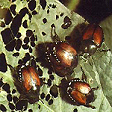
Image by Ohio State University
Period of Activity
The adult is active and the eggs are laid from summer to autumn although the female adult normally lays its eggs in the first seven to ten days of its life.
Life Cycle
The tiny white eggs are up to 1.5mm long and are deposited on the soil where they can absorb moisture. After hatching the whitish larvae are a typical curl grub and identified by a serious of bristles in a 'V' shape on its raster. There are three larva stages with the mature larvae growing to 32mm long, then pupate in the soil. The pupa is cream at first becoming red-brown and growing to 14mm long. Adults are oval shape, metallic green 10mm long by 7mm wide with brownish wing covers and five tufts of whitish hairs on either side of the abdomen.
Adult beetles emerge in early summer and find a suitable host plant to feed on, and then release an odour that attracts other emerging beetles to that plant. The females attract the males by emitting a pheromone and matting can occur on the host plant or on the ground. Fertilised females burrow into the soil up to 100mm to deposit up to five eggs then returning to the host plant and mate again. During the summer period the female deposits up to 60 eggs and under hot conditions the eggs can hatch within nine days. Under cooler conditions it can take up to thirty days for the eggs to hatch. Emerging larvae feed on the roots of the host plant.
Damage Caused
The adults skeletonize leaves and chew on buds or flowers, sometimes completely defoliating the host plant. The skeletonised leaves soon wither and die. Turf grass becomes spongy under foot as a result of tunnelling and the grass has a withered appearance in irregular patches that will not respond to watering. On inspection by lifting the turf numerous larvae can be found feeding on the roots.
Susceptible Plants
There are many broad leafed plant species that are attacked including fruit, vegetables and ornamental plants. Roses are badly affected and may have up to 50 adults on a single bloom.
The larvae attack the roots of Turf Grass such as Poa pratensis (Kentucky Bluegrass), Lolium perenne (Perennial Ryegrass), Festuca arundinacea (Tall Fescue) and Agrostis palustris (Bent).
Many trees are particularly susceptible to attack and should not be planted around turfed areas such as golf courses. These include; Acer palmatum (Japanese Maple), Acer platanoides (Norway Maple), Quercus palustris (Pin Oak), Aesculus species (Horse Chestnut), Hibiscus syriacus (Rose of Sharon), Platanus occidentalis (American Sycamore), Prunus cerasifera (Cherry Plum), Prunus x blireana (Blireana Plum), Prunus campanulate (Taiwan Cherry), Prunus x yedoensis (Tokyo Cherry), Rosa species, (Rose), Salix species (Willow), Tilia species (Linden) Ulmus species (Elms) and Parthenocissus quinquefolia (Virginia Creeper).
Vitis, Alcea, Zinnia, Hibiscus and Dahlia species are also attacked.
Cultural Control
It is difficult to control infestations of Japanese Beetles, but certain measures such as keeping soil dry during the first larval stage or avoid planting trees that are susceptible to beetle attack around lawn areas will help. Small infestations may be removed by hand during the early morning and small crops may be covered in netting for protection.
Biological Control
There is no effective natural control, but certain species of parasitic wasps help control. Soils may be infected by Bacterial Milk Disease which after a couple of years can be efficient in controlling larvae, but infected areas should not be sprayed during this period as this may kill off the bacterium.
Chemical Control
Smaller plants may be sprayed with a contact insecticide when the insect is first seen or turf areas can be sprayed with a systemic chemical.
Note
Always read the label for registration details and direction of use prior to application of any chemicals.
PEST
NAME
Aphids
Various Aphid Species
ORDER
Hemiptera
FAMILY
Aphididae
Description of the Pest
The common name varies and aphids may be referred to as black fly, greenfly, ant cows or plant lice.
These small insects have soft globular body that is from 1mm to 8mm long and vary in colour from green, yellow, black and pink, with the winged forms being elongated. Both adult and nymphs, have piercing and sucking mouthparts.
Aphids are found on buds, flowers, or leaves and stems, preferring soft new growth. On older leaves the aphids are found in protected positions, such as under the leaf. Certain species of aphids form galls as they suck sap and may be found on the roots of the plant. (E.g. Woolly aphids and Black peach aphids)
Most aphids possess a pair of characteristic tubular projections, known as cornicles; these secrete a pheromone and a waxy fluid, which is thought to protect them from some of their predacious enemies.
White exoskeletons, honey dew and sooty mould indicate the presence of Aphids
Balsam Twig Aphid (Mindarus abietinus) is greenish and covered in a white wax and is normally found on the young shoots of conifers bending and killing the needles. It is found on Abies and Picea species.
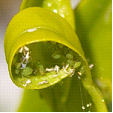 Aphid and their exoskeletons
Aphid and their exoskeletons 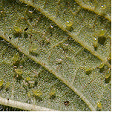 on underside of a leaf
on underside of a leaf
Black Citrus Aphid (Toxoptera aurantii) has a soft plump green body and the black coloured adults may or may not be winged. They feed in groups, curling leaves and producing honeydew attracting sooty mould.
Green Peach Aphid (Myzus persicae) is a soft plump green insect up to 0.2mm long and may be wingless. The nymphs are yellowish green and are responsible for spreading viruses in Dianthus species.
Spruce Gall Aphid (Chermes abietis) form cone shaped galls up to 12mm long resulting from the feeding. The wingless female adult lays eggs on the stems and the immature females overwinter on bud scales. Large infestation will weaken trees such as Picea abies and Pseudotsuga menziesii.
Tulip Bulb Aphid (Anuraphis tulipae) is small, waxy grey coloured and infests the underside of the bulb scales or rhizomes. They occur in the ground or on above ground parts and during storage.
Life Cycle
These insects have a Hemimetabolous life cycle, i.e. The nymphs resemble the adults.
During spring all eggs produced hatch as female nymphs. Adult Aphids are capable reproducing without fertilisation. The males are only produced in some species as the weather cools down, and the day length shortens.
Aphids are capable of giving birth to living young and large populations build up quickly during summer. Over crowding causes the aphids to become smaller, less fertile and produce more winged forms that can migrate to other host plants.
There are many different types of aphids and the life cycle varies from warm to cold climates.
Typical life cycles

Distribution of the Pest
World wide
Period of Activity
In warm climates they are seen throughout the year, but aphids dislike hot dry or cold conditions and heavy rain will decrease the population. In cold areas aphid eggs are laid around a bud base or other protected areas of the plant during autumn and emerge as nymphs during spring, feeding on the new growth.
Numbers build up quickly in the warmer months of the year. Some species feed during winter on Sow thistles.
Susceptible Plants
There is a wide range of plants attacked, from roses to vegetables, shrubs and trees. Certain aphids attack a specific genus while others have a wide range of host plants. Many are capable of transmitting plant virus diseases.
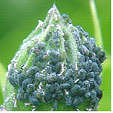 Adults and nymphs feeding
Adults and nymphs feeding 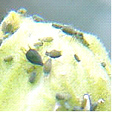 A colony of aphids
A colony of aphids
Acer species are attacked by several aphids including the Norway Maple Aphid (Periphyllus lyropictus) which is a greenish with brown markings and secret honeydew, preferring Acer platanoides. Other aphids include (Drepanaphis acerifolia) and (Periphyllus aceris) which are commonly found on the underside of leaves.
Acer species are also attacked by the Woolly Maple Aphid (Phenacoccus acericola) which covers the undersides of the leaves with a cotton-like mass
Alnus species are infested with the Alder Blight Aphid (Prociphilus tessellates) which is blue-black adult that forms woolly masses on the down-turned leaves. The nymphs overwinter in bark crevices.
Aquilegia species are attacked by several aphids including (Pergandeidia trirhoda) which is a small, flat cream coloured insect that is found on young branches and the underside of leaves.
Betula species may be attacked by the European Birch Aphid (Euceraphis betulae) which is small and yellowish or the Common Birch Aphid (Calaphis betulaecolens) which is large and green producing ample honeydew for sooty mold to grow on.
Callistephus species may be attacked by the Corn Root Aphid (Anuraphis maidi-radicis) causing the plant to become stunted, the leaves wilt and turn yellow. The aphids feed on the roots producing honeydew and are dispersed to other host by ants. It is also attacked by the Potato Aphid (Macrosiphum solanifolii).
Carya species are attacked by Gall Aphids (Phylloxera caryaecaulis) which is found on the leaves, twigs and stems forming galls and turning them black.
Chaenomeles and Gladiolus species, new growth and leaves become infested with the aphid (Aphis Gossypii)
Cupressus macrocarpa may become infested with the Cypress Aphid (Siphonartrophia cupressi).
Cyclamen species are attacked by the aphid (Myzus circumflexus) and (Aphis gossypii) which can infest healthy plants.
Dendranthema, Dianthus and Crocus species are attacked by several types of aphid including the Green Peach Aphid (Myzus persicae) and the Chrysanthemum Aphid (Macrosiphoniella sanborni).
Hibiscus species are attacked by the aphids (Aphis craccivora) and (Aphis gossypii), both congregate towards the branch tips and may cause leaf curl. Normally only seen in sub-tropical climates.
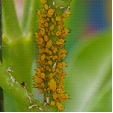 Aphids on a stem
Aphids on a stem 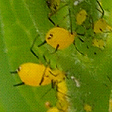 Mandevilla species
Mandevilla species
Larix species is attacked by the Woolly Larch Aphid (Adelges strobilobius). The winged adults deposit eggs at the base of the needles during spring and white woolly areas appear attached to the needles where the adult aphids feed. The young aphids overwinter in the crevices of the bark.
Mandevilla species is attacked by aphids that congregate towards the branch tips and may cause leaf curl.
Pinus species is attacked by several species of aphid including Pine Bark Aphid (Pineus strobi), Pine leaf Aphid (Pineus pinifoliae) and the White Pine Aphid (Cinara strobi).
Primula species are attacked by four species of aphid including foxglove, and green peach aphid.
Rudbeckia, Delphinium, Chrysanthemum and Helianthus species are attacked by a bright red aphid (Macrosiphum rudbeckiae).
Sorbus aucuparia is affected by the Rosy Apple and Woolly Apple aphid which attacked the foliage and young shoots.
Spiraea species are attacked by the Aphid (Aphis spiraecola) which feeds on the young shoots and flowers.
Tropaeolum species are attacked by the Black Bean Aphid (Aphis fabae), which is found in large numbers on the underside of the leaves, turning them yellow and causing them to wilt then die.
Tulipa, Iris, Freesia, Gladiolus and Zephyranthes species are infested with the Tulip Bulb Aphid.
Ulmus species are infected by two types the Woolly Apple Aphid (Eriosoma lanigerum), which curls and kills young terminal leaves and the Elm Leaf-Curl Aphid (Eriosoma ulmi) which occasionally attacks the trees.
Viburnum species are attacked by the Snowball Aphid (Anuraphis viburnicola). This aphid congregates at the end of the branches causing the leaves to curl and become deformed under which they hide.
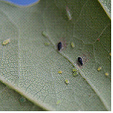 Aphids on Quercus robur
Aphids on Quercus robur
Damage Caused
Buds that have been attacked may not open, leaves and twigs become twisted or distorted and wilt. The aphids also produce honeydew, which is sticky and attracts sooty mould (fungus). This fungus forms a thick layer over the leaf, fruit or stems reducing the plants photosynthesis capability. The sooty mould spoils the plants appearance and its fruit, as does the insects white exoskeletons.
Control
Cultural Control
Aphids may be removed from a plant by hosing them off with water (limited success) or applying soapy water to aphids.. Another organic sprays can be efficient in controlling aphids. Aphids may also be removed physically by hand for small colonies on spine less plants. Species that live under ground are difficult to control but cultivation of the surrounding soil may help in controlling the infestation. (limited mainly to annual or commercial crops)
Reflective mulch around the plants also reduces numbers by repelling the insect this material is available commercially. (Reflective mulches are mainly used in market gardens for avoiding the Green peach Aphids) Resistant rootstocks are available to avoid some root feeding aphid of commercial plants, e.g. Vines and fruit trees
Biological control
Aphids are attacked by several insects includes parasitic wasps or predators such as ladybirds/ lady beetles, hover flies, lacewings, spiders.
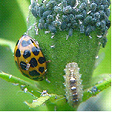
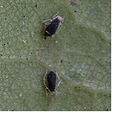 Parasitised aphids
Parasitised aphids
Chemical Control
Aphids may be controlled by spraying with a contact or systemic insecticide. The type of application used will depend on the plant is being attacked.
Aphids can be suffocated and therefore controlled with the use of e.g. White oil, Pest oil, Soapy water from soap such as Lux Flakes ®
Note
It is your responsibility by law to read & follow the directions on the label of any pesticide
Monitoring
Aphid are attracted by yellow colour and traps such as boards painted yellow and covered in glue or sticky substance will attract and trap the insects. There is also a commercially sticky yellow tape that can be attached to susceptible plants
Amendments by B. Sonsie Dip Hort Sc Burnley
PEST
NAME
Beetles (General)
Various Beetle Species
ORDER
Coleoptera
Description of the Pest
There are many different types of beetles both adult and larvae feed and have chewing mouth parts.
Agave snout weevil (Scyphophorus acupunctatus)
The Agave snout weevil or sisal weevil is a beetle up to 15mm long. It has a dull brownish-black body with a long protruding snout and chewing mouth parts. The adult female lays eggs at the base of the leaves where the hatching larvae feed on the succulent centre of the leaf with their chewing mouth parts and cause significant damage. Decay microbes then entre through the wounds and cause the plant to die by collapsing from the base.
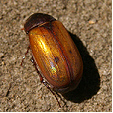
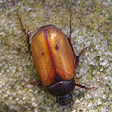 Brown (Scarb) Eucalyptus Beetle
Brown (Scarb) Eucalyptus Beetle
Brown Eucalypt Beetle (Lepidiota rothei) adult is brown with hairy legs and grows to 20mm long. It has chewing mouth parts and feeds on the leaves, sometimes swarming and stripping the host tree. The lava is cream coloured curl-grubs that feed on the roots of the tree. The feeding habits of this beetle are very simular to the Christmas Beetle (Anoplognathus species), eating new shoots and leaves to the mid rib, commonly attacking Eucalyptus species.
European Bark Beetle (Scolytus multistriatus) female adult is reddish up to 3mm long and lays its eggs in tunnels in the sap wood and the emerging lava tunnel through the bark forming tiny holes. This beetle is regarded as a main transmission source for Dutch elm disease that infects Ulmus species.
European Willow Beetle (Plagiodera versicolora) is metallic blue up to 4mm long and overwinters in the bark. During spring the yellowish eggs are laid and the emerging lava skeletonise leaves by feeding on the underside. There can be two generations per year and attack Salix species.
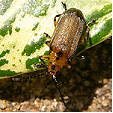 Fig Leaf Beetle
Fig Leaf Beetle 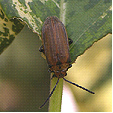
Fig Leaf Beetle (Poneridia semipullata) is a dull brown adult has a reddish brown head and growing to 12mm (¼in) long with prominent antennae. It deposits up to 50 eggs that are in groups on the underside of the leaf. The yellowish spiny larvae are small and appear as sawdust on the leaf. As they mature they turn blackish and grow to 12mm (¼in) long, widest at the head.
It prefers coastal tropical to warm temperate regions and both adult and larvae feed on the leaves. The larva graze in groups skeletonising the leaves and making plants look unsightly.
Figwort Weevils generally the adult beetles are normally black to greyish white, up to 4-5mm long with one or two black circular marks where the wing cases meet. The larvae are yellowish to brown grubs with black heads up to 6mm long and have a slimy texture.
The larvae pupate in spherical cocoons that it spins and is attached to the host stems. The cocoon resembles the seed pods of Scrophularia species (Figwort). Adults overwinter in leaf litter or the soil emerging during spring and lay eggs on the host plant. There is normally two generations per year.
The larvae feed on leaves by grazing the surface of the leaf eating the epidermal layer. The leaf turns brown, shrivels and dies. Many plants are susceptible, including Hibiscus, Dahlia, Vitis species and avocados, potatoes, sweet potatoes, rhubarb, and various weed species.
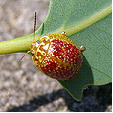
 Paropsis species adult and larvae
Paropsis species adult and larvae 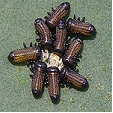
Leaf-eating Beetles in the Chrysomelidae family are found throughout the world with over 3,000 species in Australia. Generally small smooth and colourful, globular or flattened up to 15mm in length with antennae one third the length of the body. Normally adults and larvae feed on the living tissue of the leaves. There are many sub-families including Sagrinae containing the larges species, Bruchinae containing larvae that eat seeds and the larges subfamily Chrysomelinae contains many species such as Paropsis species. These beetles are characteristic dome shape and are commonly seen on Eucalyptus species.
Mountain Pine Beetle (Dendroctonus ponderosae) is a dark brown to blackish adult beetle up to 7.5 mm long. There are 4-larval stages that include a white larval with no legs that appear from vertical egg galleries and mature larval produce oval pupation cells towards the end of the tunnels in the tree. They emerge from small openings at the tunnel end as adults. This pest affects millions of hectares of forest in North America and Canada including many species of Pinus. It normally attacks older weaker trees but under ideal conditions it attacks healthy trees. Pinus albicaulis has become endangered due to the actions of this species. Numerous beetles can attack a single tree and the larval attack on the cambium layer can be accompanied with a fungal attack such as the Blue stain fungi (e.g. Ceratocystsis and Ophiostoma spp.) causing death of the tree. Symptoms include the needles in the crown wilt then turn orange-red for many months then become brown before falling to the ground. Pitch tubes can be located towards the lower part of the tree and consist of frass and resin.
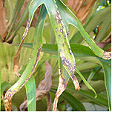 Staghorn Beetle Damage
Staghorn Beetle Damage
Staghorn Beetle (Halticorcus platyceryi) is a small rounded beetle that is black with four dull red spots on the wing covers. It has pinkish lava and both larvae and adult feed on the epidermal layer of fronds leaving small brownish sunken areas.
Wattle Blight (Paropsis orphana) adult is a light green oval-shaped beetle with white stripes on its wing covers up to 6mm long. The small lava has a tapering shape and both adult and lava feed together in groups on the surface of Acacia species leaves turning them brown.
Vegetable Weevil (Listroderes difficilis) is found during cooler weather (spring or autumn). The adult brown beetle up to 19mm long with a "V" mark on its back and the eggs are laid in the soil around the base of the host plant. The cream coloured lava emerges in spring after rain and feed on the lower leaves forming irregular holes or chewing holes in stems. The lava also feed on fleshy roots boring holes into carrots. Both the adults and lava cause damage, feeding on the plant during the night and resting at the base or under ground during the day. The lavae pupate in the soil over winter.
Life Cycle
This insect has a Holometabolous life cycle, i.e. it has a larval and a pupal stage.
Distribution of the Pest
Beetles are found world wide.
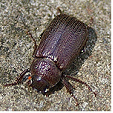
Period of Activity
The beetles are active from spring to mid summer preferring the warmer weather.
Susceptible Plants
The beetles attack many species of trees, shrubs, ferns and small plants as in potted plants in nurseries.
Anemone and Clematis species are attacked by the Black Blister Beetle (Epicauta pennsylvanica) which eats the leaves and flowers.
Callistephus species are attacked by the Asiatic Garden Beetle (Autoserica castanea) that chews on the foliage at night and hides in the soil or around the base of the plant during the day.
Carya species are attacked by the Bark Beetle (Scolytus quadrispinosus). The tiny adult beetle is brown up to 5mm long and the legless lava tunnel the bark and sapwood where it over winters, causing ringbarking. Twigs and small branches wilt and die.
This species is also attacked by the Twig Girdler (Oncideres cingulate), a reddish beetle that is 20mm long and produces small lava that girdles twigs by tunnelling, where it overwinters. This weakens the twigs causing them to snap off or results in ringbarking.
Cheiranthus species may be attacked by the Red Turnip Beetle (Entomoscelis americana) which is bright red with black markings in its head and wing covers and feeds on the foliage.
Eucalyptus species and other plants in the Myrtaceae family are attacked by the Flower Scarab Beetle (Protaetia species) a rounded brownish adult that grows to 20mm long, feeding solitary on flower pollen or new growth causing wilting and twig dieback. The insect is found from tropical to temperate regions and is regarded as a minor pest. Eucalyptus are also attacked by Leaf-eating Beetles which eat irregular pieces from the margins.
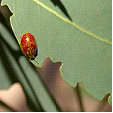 Damaged Margins on Eucalyptus by the Leaf-eating Beetles
Damaged Margins on Eucalyptus by the Leaf-eating Beetles
Protea species are also attacked by the Flower Scarab Beetle.
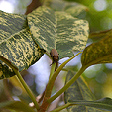 Ficus species
Ficus species 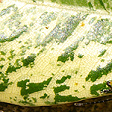 Damaged epidermal layer
Damaged epidermal layer
Ficus species are susceptible to the Fig Leaf Beetle (Poneridia semipullata). Both adult and larvae feed on the leaves eating the epidermal layer and making the plant in large infestations look poorly.
Ulmus species are attacked by the European Bark Beetle and the Leaf Beetle (Galerucella luteola) adult, which eats areas out of new leaves.
Ficus species are susceptible to the Fig Leaf Beetle (Poneridia semipullata). Both adult and larvae feed on the leaves eating the epidermal layer and making the plant in large infestations look poorly.
Samanea saman fruit pods are attacked when the burchid beetle (Merobruchis columbinus) oviposits in the immature fruit. The lava can kill or damage up to 75% of the seeds but is not commonly a major problem.
Solanum tuberosum is attacked by wireworm (Agriotes species). The larvae of this beetle, tunnels into the tubers. It is best controlled by planting in the soil which has not been affected previously.
Ulmus species are attacked by the European Bark Beetle and the Leaf Beetle (Galerucella luteola) adult, which eats areas out of new leaves and its lava skeletonise the underside of mature leaves later in the season.
Damage Caused
Some beetles and their larvae may eat the leaf surface in bands leaving the veins intact while other larger beetles tend to eat leaves from the margins preferring new shoots.
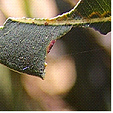 Beetle damage
Beetle damage
Cultural Control
Small infestations may be removal by hand where possible.
The Brown Eucalypt Beetle will not fly during the night and if disturbed by shaking or beating the tree, fall to the ground where they can be collected on a tarp that is laid under the tree then destroyed. This method also works on the Flower Scarab Beetle that fall to the ground pretending to be dead when disturbed.
Biological Control
Beetles are eaten by predators including birds, frogs, and lizards and are attacked by parasitic wasps.
Chemical control
Will vary with the pest, the plant on which it is found. The part of the plant being attacked.
Note
It is your responsibility by law to read & follow the directions on the label of any pesticide
Amendments by B. Sonsie Dip Hort Sc Burnley
PEST
NAME
Borer (General)
Various Borer Species
ORDER
Various
FAMILY
Various
Description of the Pest
Generally the larvae bore holes into the heartwood, sapwood or down the centre of twigs though not all borers attack trees. These tunnels may be small or large, deep or shallow and when they emerge from their tunnels at night, they feed on the surrounding tissue. Entrance holes may be covered by a layer of chewed wood fragments ("frass"), silk webbing or exposed and the tunnels may be solitary or form galleries. Certain species attack only twigs and young shoots, while others attack the trunk or roots.
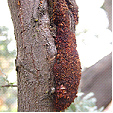 Fruit tree moth borer damage
Fruit tree moth borer damage
The adults female of a fruit tree moth borer normally deposits eggs in damaged areas of the bark or where there is and existing active site. The larvae vary but generally they are creamy to brown, thick soft grub-like reddish brown, and up to 40mm in length.
The adults are white, satiny moths with 40-60mm wingspans with their black abdomens fringed with orange-brown hair or beetle lava that has been deposited in the bark or twigs then tunnels the host.
American Plum Borer (Euzophera semifuneralis) lava is pinkish white to brownish green and attacks the inner bark and cambium region of the tree causing premature death. It is normally found on Platanus orFraxinus species and may also infest many species of fruit trees.
Apple Root Borer (Leptopius squalidus) female adult is a weevil to 20mm long and feeds on the leaves and the plump, legless grub-like lava feeds on the roots of the same host forming tunnels in the deep roots. It is commonly found on Acacia and Eucalyptus species damaging the anchorage of the plant.
Banksia Borer (Cyria imperialis) adult is a black beetle with yellow markings on its wing covers growing to 15mm long. The thickish legless lava is white, tapering from the head and forms flattened tunnels into the heartwood of the host.
Bronze Birch Borer (Agrilus anxius) is a bronze coloured beetle up to 14mm long and lays eggs in crevices in the bark. The legless white larva grows to 20mm long and feeds on the sapwood girdling the branch with flat irregular galleries.
Cedar Tree Borer (Semanotus ligneus) is a black beetle with orange and red markings on its wing covers and grows to 12mm long. The larva feeds on the sapwood of Sequoia, Thuja species and Pinus radiata with curved tunnels that may girdle branches.
Chestnut Borer (Agrilus bilineatus) adult is a tiny slender, blackish green beetle up to 8mm long emerging during spring. The small white larvae have a flat head and are up to 15mm long, forming galleries under the bark of Quercus species.
Cypress Bark Beetle (Phloeosinus cupressi) adult is dark brown with a blackish head, oblong in shape up to 3mm long. The tiny beetles tunnels under the bark of the host and deposits eggs. After hatching the tiny 4mm long, legless larvae bore into the heartwood damaging the tree. After they pupate in the tunnel they emerge through small round holes, commonly many together on the trunk. Damaged trees show signs of browning and dead leaves in the upper branches or falling damage twigs. Cupressus species are particularly vulnerable to attack.
Deodar Weevil (Pissodes nemorensis) is brownish with an obvious snout feeding on the cambium layer and deposits eggs in the bark of the leader and branches. The white lava tunnel the wood eventually killing the leader.
European Corn Borer (Pyrausta nubilalis) is a small moth that lays up to twenty eggs on flower buds. The young flesh coloured larvae mature to a reddish brown and each of its segment has four, spined dark spots.
Elephant Weevil (Orthorhinus cylindrirostris) is a grey or black insect up to 20mm long and lays eggs in the bark near the base of stressed trees. The larva tunnels its way through roots or trunks depositing frass as it goes, then emerging from a second round hole. The adults eat strips from the leaves, normally not bothering the plant.
Elm Borer (Saperda tridentate) adult is a greyish beetle with red bands and black spots on its wing covers and is up to 12mm long. The eggs are laid on the bark and the whitish lava tunnels into the bark and sapwood where it overwinters. It is normally found on Ulmus species.
Iris Borer (Macronoctua onusta) is born from a grey moth with a wing span up to 30mm across, and lays eggs that overwinter in old leaves and debris. As the leaves emerge the eggs hatch entering the leaves at the base, visually forming tunnels and growing to 30mm long. In the later season flower buds may be attacked. Both flowers and leaves eventually turn brown and die.
Lilac Borer (Podosesia syringae) adult is a wasp-like moth that produces pure white lava with a brown head that are up to 25mm long. It initially feeds in the sapwood causing wilting before tunnelling the hardwood making the branches brittle. Evidence of frass is found at the tunnel entrance and secondary fungal attacks infect the holes. Normally found on Syringa species.
Locust Borer (megacyllene robiniae) adult is a black beetle with golden spots, up to 20mm long and produces a small larva that tunnels galleries into the sapwood causing a blackish discolouration. Robinia species are normally attacked.
Mottled Borer (Cryptorhynchus lapathi) attacks Salix species. The adult beetle is black up to 10mm long and the lava bore into the surface of the stem causing swollen growth. Salix species are attacked.
Murry Pine Borer can be two species (Diaoxus erythrurus) and (Diaoxus scalaris). The adults are glossy green-brown beetles that are up to 20mm long and the white grub-like lava is legless, tapering from the head. They tunnel into the sap or hardwood of the trees forming connecting galleries causing ringbarking and creating brittle branches, commonly fond on Callitris species.
Peach Borer (Sanninoidea exitiosa) is a larva that tunnels roots causing gummosis that is mixed with frass at the crown just below soil level. The affected Prunus species produce yellowish leaves and grows poorly. There is another borer, Lesser Peach Borer (Synanthedon pictipes) which attacks any part of the plant from the trunk to the branches and is found on several Prunus species.
Puriri Moth (Aenetus Virescens) a New Zealand short lived moth that grows with a wing span of over 100mm (4in) wide laying eggs on the forest floor at night during spring. The caterpillars grow to 100mm long feeding on leaves and then ascending into the trees and entering the cambium layer up to 150mm deep forming a characteristic '7'-shape burrow that is concealed by frass. The caterpillar may live for 7-years before pupating and collectively they ring bark branches or trunks causing dieback.
Many New Zealand plants including Nothofagus solandri, Pomaderris spp.and ornamentals such as Quercus spp. Betula pendula, Salix spp. Populus spp. Acer spp. Citrus limon and Paulownia spp. are attacked. Control is difficult and generally the plants tolerate attack.
White Pine Weevil (Pissodes strobi) lava feed on the inner bark and sap wood of terminal shoots causing ringbarking and death of the shoot. The reddish brown beetle up to 6mm long is mottled in white and emerges during early summer then lays yellowish lava that are up to 9mm long.
Scribble Moth (Ogmorgraptis scribula) is a grey moth up to 0.4mm wide and produces a cream to brown larvae that is also about 0.4mm long and tunnels in the bark causing a scribble effect. This normally has no detrimental effect on the tree.
Spotted Hemlock Borer (Melanophila fulvoguttata) adult is a colourful metallic beetle with yellowish red spots on the wing covers and lays eggs in cracks in the bark. The white lava is up to 14mm long and forms galleries in the bark and sapwood of the host.
The large Swift Moth and Wood Moths can have a wing span up to 250mm wide and produce large larva that are grub like up to 150mm long, some with horny plates on the thorax. These larvae bore tunnels that are up to 30mm across straight through the heartwood of the host plant. The larvae may live in the tunnel for up to five years before pupating.
Red Cedar Bark Beetle (Phloesinus dentatus) is a small beetle up to 3mm long and lays its larva in excavations in the bark. When the larva emerges they bore galleries in the bark and tend to be more prevalent in stressed or recently transplanted plants.
Vegetable Weevil (Listroderes difficilis) is found during cooler weather (spring or autumn). The adult brown beetle up to 19mm long with a "V" mark on its back and the eggs are laid in the soil around the base of the host plant. The cream coloured lava emerges in spring after rain and feed on the lower leaves forming irregular holes or chewing holes in stems. The lava also feed on fleshy roots boring holes into carrots. Both the adults and lava cause damage, feeding on the plant during the night and resting at the base or under ground during the day. The lava pupates in the soil over winter.
Wattle Web-covering Borer (Cryptophasa rubescens) adult is a satin coloured moth that is up to 50mm across and deposits green fleshy lava that is up to 35mm long. The lava forms shallow tunnels in the bark and sap wood of the host and camouflages it with chewed wood and faeces that is webbed together. Commonly seen attacking the branches on Acacia species.
Life Cycle
These insects have normally have a Holometabolous life cycle. But some borers such as Termites have a Hemimetabolous life cycle.
Eggs are laid singly or in groups, in damaged areas of the bark and branch. Larvae shelter in tunnels they create in the wood and some species may take many years to pupate and emerge as an adult. This may take place in live or dead wood. Other species such as Corn Borer can have up to two generations per year.
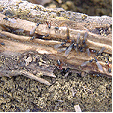 Termites and their damage
Termites and their damage
Distribution of the Pest
Borers are found throughout the world with many species found in Australia both on the coast and inland.
Period of Activity
Varies with the insect concern. Many larvae can be active for many months. Termites are active all year.
Damage Caused
Most damage appears on branches or trunks where the larvae feed on the soft tissue and extensive feeding may cause ring-barking. Normally plants survive borer attack but repetitive attack will cause the death. Certain species are a serious pest in plantations or monocultures such as the Pine Bark Weevil, and the Sirex wood wasp.
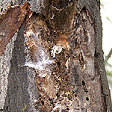 Typical borer damage by a moth larva
Typical borer damage by a moth larva
Chestnut Borer feeds on the sap wood ringbarking large branches and overwinters in the tunnels.
Corn Borer feeds on flower buds and leaves resulting in there death, after which the larva tunnel down the stem causing wilting. There are many crop plants and ornamentals that are affected by this larva.
Swift Moth and Wood Moths weaken trees by boring large tunnels through the branches that may not be noticed until holes are cut through the bark during emergence.
Iris Borer damages leaves to turn brown and wilt, flowers also turn brown and with the aid of a bacterial rot, collapse and die. This damage may be extended to the flower stalk.
Stem Borer (Papaipema nebris) is a small lava to 12mm long, and attacks many garden plants including Lilium, Aster, Alcea and Phlox species
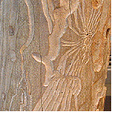 Borer Damage
Borer Damage  Resin oozing from a trunk
Resin oozing from a trunk
Susceptible Plants
There are many plants that are attacked by these pests including Banksia, Callistemon, Melaleuca, Lagerstroemia, Jacaranda species, and flowering stonefruit. Eucalyptus, Acacia species and many ornamental such as Acer species. Plants that are stressed, are particularly venerable.
Acacia and Eucalyptus species are attacked by Swift Moths and Wood Moths.
Acacia species are susceptible to attack from the Wattle Web-covering Borer (Cryptophasa rubescens), which weakens and causes die back of branches.
Acer platanoides is attacked by the Leaf Stalk Borer (Nepticula albostriella) that tunnels into the petiole of the leaf turning it blackish and also attacks the fruit.
Acer saccharinum is attacked by the Petiole Borer (Caulocampus acericaulis) which tunnels in the petioles. It generally attacks the leaves on the lower branches causing them to fall.
Acer species may also be attacked by several borers including the Flat Headed Borer (Chrysobothris femorata), a 25mm long lava of a coppered coloured beetle, that tunnels galleries under the bark girdling the trees The Sugar Maple Borer (Glycobius speciosus) which girdles branches killing them and the Leopard Moth (Zeuzera pyrina) lava that tunnels large holes into branches making them structurally weak. This lava can grow to 80mm long and 12mm thick overwintering in the tunnels.
Banksia species are attacked by the Banksia Web-covering Borer (Xylorycta strigata) a greenish lava up to 40mm long that tunnels down the centre of branch tips. The entrance is covered in silken web littered with faecal material and causes the death of the branchlets.
Betula and Populus species are attacked with the Bronze Birch Borer (Agrilus anxius) and heavy infestation may kill the tree. Populus species are also attacked by the Poplar Borer (Saperda calcarate).
Brachychiton species are attacked by the Kurrajong Weevil (Axionicus insignis) the lava of this plump greyish weevil is white and legless, entering the plant through wounds forming rounded tunnels that may girdle the tree, killing it.
Carya species are attacked by the Painted Hickory Borer (Megacyllene caryae). The adult dark brown beetle has obvious zig zag lines on its wing covers and the lava is cream coloured, both up to 20mm long. The lava tunnels the sapwood of living trees causing ring barking and also tunnels dead trees.
Cornus species are attacked by several borers such as the Flat Headed Borer (Chrysobothris femorata) and the Dogwood Borer (Thamnosphecia scitula).
Cupressus species are attacked by the Cypress Bark Beetle (Phloeosinus cupressi) causing the branches to turn brown and die off from the top or causing the leaves to wilt. On first indication of infestation selective prune off damaged areas or remove the tree.
Hakea sericea and other Hakea species are attacked by the Web-covering Borer (Neodrepta luteotactella). The larvae bore into the twigs and fruit forming a small covering of frass. This insect also infects Macadamia species. Hakeas are also attacked by several other web-covering borers.
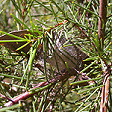 Hakea sericea
Hakea sericea
Pinus and Picea species are attacked by the White Pine Weevil (Pissodes strobi) in the northern hemisphere.
Samanea saman is attacked by the borer (Xystrocera globosa) which chews into the sap wood of stressed trees and can cause serious damage.
Sorbus aucuparia is attacked by the Round Headed Borer (Saperda candida) which forms galleries in the trunk at ground level, forming round holes in the bark.
Tilia species are attacked by the European Bark Borer (Chrysoclista linneela), which feeds on the bark and thew Linden Borer (Saperda vestita) that attacks the base of the trunk or roots.
Tsuga species are attacked by Spotted Hemlock Borer (Melanophila fulvoguttata).
Vaccinium ovatum is infested by the Azalea Stem Borer (Oberea myops). The yellowish lava of this beetle bores into the tips of stems during the flowering period and is up to 12mm (½in) long. It is also commonly found on Rhododenron species.
Control
Cultural Control
Larvae may be destroyed after exposure by pulling away the covering pad of frass, or by pushing a length of wire into the tunnel. Damaged branches may be removed. Improve the culture by feeding and watering the plant.
 Frass due to the Fruit tree moth borer
Frass due to the Fruit tree moth borer
Biological Control
No effective biological control though certain species of trees exude gum or resin sealing the holes and limiting the activity of the larvae or causing its death.
Chemical Control
There is no satisfactory chemical control most borers of live wood.
Note
It is your responsibility by law to read & follow the directions on the label of any pesticide
PEST
NAME
Lace Bug
Various Lace Bug Species
ORDER
Hemiptera
FAMILY
Tingidae
Description of the Pest
The adult Azalea Lace Bug (Stephanitis pyrioides) is up to 4mm long and has a blackish body with transparent lacy wings. The dark-brown nymphs and the adults have piercing and sucking mouthparts. It is an introduced pest to Australia in the family Tingidae and is illustrated in the photos below.


Appearance of the Pest
These insects have a Hemimetabolous life cycle, ie. When the immature nymphs resemble the adults.
The adult lays eggs on the underside of leaves along the main veins or the mid rib during spring. The sap-sucking nymphs are dark brown with spines protruding from their sides.
Period of Activity
The nymphs appear during spring with the new growth and persist throughout summer.
Susceptible Plants
Cotoneaster, Crataegus and Amelanchler species are attacked by the lace bug (Corythucha cydoniae).
Dendranthema species are attacked by the lace bug (Corythucha marmorata) which causes the leaves to become mottled from the sap sucking habits of the adult and nymphs.
Olea species are attacked by a simular species the Olive Lace Bug.
Rhododendron species (Azaleas) are attacked by the Azalea Lace Bug (Stephanitis pyrioides).
Salix species is attacked by the lace bug (Corythucha mollicula) which turns leaves mottled yellow.
Ulmus species are attacked by the Elm Lace Bug (Corythucha ulmi), which infests new growth causing spotting of the leaves that eventually die. Black spots of excreta are commonly seen on the leaves.
Damage Caused
The nymphs suck the sap from the leaf underside and excrete black sticky blobs on the surface. The upper surface becomes blotched white to grey, which permanently damages the leaf. Damaged plants look unsightly or ill in the garden.

 Blotched Upper Surface
Blotched Upper Surface
Cultural Control
It is difficult to control, infested areas may be shaken to evict the insect on small plants or affected areas may be sprayed with soapy water.
Chemical Control
Affected plants may be sprayed with a penetrant or systemic insecticide, which only delivers a satisfactory result and is very difficult to apply on large plants. These chemicals should be applied as soon as the damage starts to appear.
Note
Always read the label for registration details and direction of use prior to application of any chemicals.
PEST
NAME
Tip Borer
Various Tip Borer Species
ORDER
Various
Description of the Pest
There is many species of moths which are brown, blackish or white up to 30mm long. Generally the fleshy, greenish to cream coloured larvae grow to 25mm long and are sparsely hairy. The Callistemon Tip Borer is laid by a metallic to blackish moth and the larvae are creamy grubs that have true legs. Some larvae are very active when disturbed such as the fleshy Macadamia Twig Girdler which has darker strips on its body and a dark head.
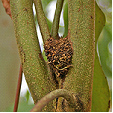 Dieback Borer Damage
Dieback Borer Damage
Dieback Borer (Platyomopsis armatula) adult is a grey-brown beetle up to 20mm long with small lumps on its wing covers and long antennae. The 15mm long cream coloured larva tunnel under the bark and feed on the sapwood causing ringbarking. The entrance to the tunnel is covered in frass and plants in the Myrtaceae family such as Eucalyptus species are susceptible.
Elm Twig Girdler (Oberea tripunctata). The adult beetle feeds on twigs causing girdling then deposits eggs during spring. The lava tunnels down the centre of the stem from the girdled point and overwinters in the tunnels. Twigs up to 14mm diameter may snap off at the damaged point and Ulmus species are normally the host.
Mahogany Shoot Borer (Hypsipyla grandella). The adult is a greyish-brown moth with a wingspan up to 45mm with the wings and veins distinctly overlayed in black. It deposits oval eggs that are tiny 0.50mm wide normally deposited in the leaf axil and change colour from white to red in the first 12 hours. In 3 to5 days the larvae emerges and can grow to 25mm long and is brownish white when young and maturing to bluish with a brown head capsule. Swietenia species are damaged as the larvae bore into the new shoots normally during spring or during the rainy season. The shoots and branches wilt then collapse. This is a major economic pest for cultivated trees.
Red Cedar Tip Moth (Hypsipyla robusta) adult is a grey moth with a wing span up to 20mm across and produces fleshy lava with true legs up to 20 mm long that tunnels into the tips of twigs. The tunnels are surrounded by webbing that is littered with pelleted droppings and is normally found on Toona species.
Staghorn Borer larvae grow to 15mm long and are greyish with true legs and the grey adult moth has a wingspan up to 20mm across. It attacks Platycerium species by eating tunnels into the sterile fronds.
Appearance and Distribution of the Pest
They are found mainly on the coast but also inland and are distributed by flying with the assistance of wind.
Life Cycle
These insects have a Holometabolous life cycle, ie. When metamorphosis is observed during the pupal stage.
Eggs are laid in bark on the growing tips. Larvae shelter in tunnels they create in the wood, up to 20mm deep.
Period of Activity
Active throughout the year in warm climates and are commonly found from tropical to sub-tropical and temperate regions.
Damage Caused
Generally the symptoms of tip borers is yellowing and curling of the leaves which wilt then die or shoots become blackened and are noticeable in the tree. Extensive feeding by a number of larvae causes dieback but normally, this is a minor pest.
The larvae emerge from their tunnels at night, to feed on the bark around the entrance holes. Entrance holes are covered by a layer of chewed wood fragments ("frass") and silk webbing. Most damage appears on twigs and new growth.
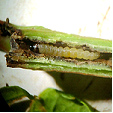 Typical larvae
Typical larvae
The Callistemon Tip Borer tunnels down the centre of the twigs causing then to die or break off and the Macadamia Twig Girdler (Neodrepta luteotactella) form tunnels in sapwood that are covered in fine webbing that is dotted in brown excreted pellets. This is the same appearance as the Banksia Web-covering Borer (Xylorycta strigata) larva makes, as it tunnels down the centre of shoots.
Susceptible Plants
Many native and ornamental plants are susceptible to tip borers such as Callistemon, Melaleuca, Banksia, Hakea, Macadamia and Stenocarpus species
Eucalyptus, Callistemon, Corymbia, Leptospermum and Melaleuca species are attacked by the Dieback Borer (Platyomopsis armatula). Twigs and small branches are attacked and the larvae causes ring bark. Affected branches break easily in high winds.
Sambucus, Yucca and Delphinium species are attacked the Common Stalk Borer (Papaipema nebris) which attacks the stems causing the plant to wilt and topple over.
Cultural Control
Larvae may be destroyed after exposure by pulling away the covering pad of frass, or by pushing a length of wire into the tunnel. Damaged branches may be removed, or tunnels plugged. Infested perennials or annuals should be removed and destroyed.
Biological Control
No effective biological control.
Chemical Control
Spray with Carbaryl (including the trunks or stems) if necessary while the insects are active.
Note
Always read the label for registration details and direction of use prior to application of any chemicals.
PEST
NAME
Leafminer (General)
Various Leafminer Species
Description of the Pest
There is a wide range of insects that have larvae, which mine leaves and these are found throughout the world. These include beetles, wasps, sawflies, moths and flies. The larvae may or may-not have legs, but are normally flattened.
These insects have a Holometabolous life cycle, ie. When metamorphosis is observed during the pupal stage.
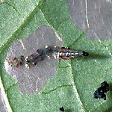 Typical Leafminer
Typical Leafminer 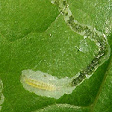
Cigar Case Bearer (Coleophora caryaefoliella) adult is a brown moth with fringed wing margins up to 9mm across. The tiny lava has a black head and feed beneath the epidermal layer of the leaf and over winters in small cigar-shaped cocoon. Commonly found on Carya species.
Cineraria Leaf Miner (Chromatomia syngenesiae) is in the family Agromyzidae. This insect has a complete metamorphosis: egg, larva, pupa and adult. The adult is a small (2mm) black fly. Female adults puncture the undersides of leaves to feed on the sap. Cream coloured larvae (maggots) are miners, up to 5mm long, and their tunnels appear as a tracery of irregular white lines on the leaves, through which the larvae will be visible on the lower surfaces. The pupa is darker-coloured, barrel-shaped and up to 2.5 mm in length.
The feeding of females causes small rust-like spots to appear on the upper surface of leaves. The eggs are deposited on the undersides of the leaves. The tunnels of the larvae become wider as the insect grows and may eventually cause the infested foliage to wilt. Heavily infested plants will die; more often, the appearance of the plant is spoilt by the disfigured leaves, even though it will still produce flowers.
Cypress Moth (Recurvaria apicitripunctella) female adult is a small, yellowish with fringed wings and black markings. The larva tunnels into leaves and then ties them together with silken web, it found on Taxodium mucronatum.
Grevillea Leaf Miner (Peraglyphis atimina) a tiny larvae that eats the inner tissue of leaves and forms tunnels that expand as they grow.
The Leaf Miner (Epinotia nanana) is an olive green caterpillar with a brown head that attacks the base of the leaf and webs them together as it progresses. It is found in Tsuga species.
The Leaf Miner (Lithocolletis crataegella) lava forms tunnels in the inner tissue of the leaf, which becomes wider forming blisters that turn light brown. It normally occurs during late spring attacking unfolded leaves of many plant species including Crataegus.
Macadamia Leaf Miner (Arocercops chionosema) larva forms tunnels that lead to blisters in the leaves and the adult moth is brown with silver bands.
Damage Caused
There is a range of symptoms as a result of attack. Damage appears initially as tunnels on the underside of the leaves, which become broader. The leaf may form blisters and turn a rusty colour with patches visible on both sides. Continual feeding can cause the leaf to fall prematurely and give the plant an unattractive appearance. This attack is a serious problem in a forestry situation but is normally insignificant in a domestic garden. Attacks may be sporadic.

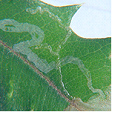 Banksia integrifolia
Banksia integrifolia
Cineraria Leaf Miner
Tunnels begin to appear in early spring and continue through early summer, particularly during cooler, humid periods. The adult fly is inconspicuous and tends to go unnoticed - its presence is indicated by the appearance of the rust-like spots on the leaves as described above. Tunnels of larvae, in which the maggot pupates, may become up to 2mm wide and cover most of the surface of the foliage.
Period of Activity
The larvae are active from summer to autumn and are found from the tropics to temperate regions and generally the eggs are laid on the underside of leaves.
Susceptible Plants
There is a wide range of ornamentals and native plants that are attacked by leaf miners, including vegetables, perennials, annuals, shrubs and trees such as Nyssa sylvatica.
Aquilegia species leaves are attacked by the leaf miner (Phytomyza minuscula) which causes obvious winding white tunnels across the leaf surface.
Betula species are attacked by the leaf miner (Fenusa pusilla). The small black sawfly emerges from the soil primarily during spring. The small worm-like white lava feeds on the fresh new growth, and may cause substantial damage. Adults that emerge later in the season cause less destruction as the lava ignore mature leaves feeding only on new growth.
Buxus species are attacked by the leaf miner (Monarthropalpus buxi) that causes water soaked areas on the underside of leaves as the lava tunnels beneath the epidermal layer.
Cornus species are susceptible to the leaf miner (Chalepus dorsalis) yellowish lava up to 7mm long that tunnels the leaves causing blisters and the adult beetles skeletonise the underside of the leaves.
Leucanthemum and Dendranthema species are attacked by the Chrysanthemum Leaf Miner (Phytomyza atricornis).
Macadamia species and Stenocarpus salignus are attacked by the Macadamia Leaf Miner.
Pericallis x hybridus (Cineraria) is attacked by the Cineraria Leaf Miner (Chromatomia syngenesiae). Leafy vegetables are also susceptible, as are plants in the Asteracea family and related ornamentals such as chrysanthemums, nasturtiums, and gerberas. Sow thistle and other leafy weeds are hosts for this insect. The foliage becomes covered with unsightly, tortuous silvery lines which ultimately ruin the appearance of the plant. Heavy infestations cause wilting and death of the plants. Do not take cuttings from affected plants.
Verbena species are attacked by the leaf miner (Agromyza artemisiae), which mines the leaf margins.
Cultural Control
It is difficult to control leaf miners and damaged leaves may be removed then destroyed from localised infestations.
Biological Control
Many leaf miners are attacked by parasitic wasps and small birds which reduces numbers.
Chemical Control
Chemical treatment includes spraying with dimethoate; note that it is advisable to treat the plants before the larvae pupate and being certain to cover the new growth avoiding reinfestation.
Note
Always read the label for registration details and direction of use prior to application of any chemicals.
PEST
NAME
Caterpillars (General)
Various species
Description of the Pest
There are many types of caterpillars from moths or butterflies, cutworms, bag moths, case moths, leaf rollers leaf skeletonises. The larvae generally eat leaves, seeds, flowers or buds by chewing out pieces. The size of the piece will depend on the size of the caterpillar and generally they are voracious eaters. The method of eating varies such as the leaf skeletoniser which leaves a network of veins or whole leaves are consumed.
The larvae have mainly 4 or 5 pairs of prolegs except Loopers which have 2 -3 pairs of prolegs. The number of prolegs can help in identifying the insect.
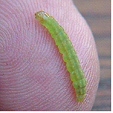 Small and Large Types
Small and Large Types 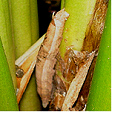
Casuarina Moth (Pernattia exposita) is gregarious, brown with a large head and tufts of hairs that line the slender body. It grows to 25 mm long and forms a tightly woven cocoon on the side of branchlets. The large female adult moth has a stocky body and generally slow moving, the male is smaller.
The larvae cause extensive damage to A. littoralis, A. stricta, C. cunninghamiana, C. glauca, and C. equisetifolia.
The hairy larva feed on the 'leaves" phyllodes, and stems, this can lead to ringbarking and death of branches.
Monitoring
Place sheets on the ground and disturb (shake) the tree for the larva drop to the ground on silken threads.
Spruce Budworm (Choristoneura fumiferana) is a reddish brown with a yellow stripe on its side and chews on the opening buds and the needles of the host. The adult moth is dull grey with brown bands and spots on the wings, appearing in early summer. The larva is very destructive in northern hemisphere coniferous forests.
Banksia Moth (Danima banksiae) is a caterpillar up to 60 mm long and is brown with black and white markings on its sides and when disturbed it arch backwards and reveal an extruded red underside, close to its head. The grey adult moth has an orange coloured body with a wing span that is up to 80mm across with black and white markings.
Banana moth (Opogona sacchari) is in the order Lepidoptera. This nocturnal moth as a wing span up to 25 mm wide and is bright yellowish brown with a dark brown spot on the wings. It has a life cycle that lasts approximately 3 months with the eggs hatching in 12 days and the whitish larva with a reddish brown head is up to, 26 mm long, and lives for 50 days at 15° C. In warmer climates life cycle is quicker with up to eight generations per season. The female moth uses a ovipositor to lay up to 500 eggs in groups of five amongst the crevices of the plant. The voracious larvae tunnel into the plant, avoiding light. In bananas it infests developing fruit and in ornamental plants it prefers the fleshy stems, particularly in cacti, begonias, African violets and is also a serious pest of Pritchardia and Chamaedorea species. Symptoms include tunnelling activity, which may be difficult to see then dead areas appear on the stems. As the caterpillars destroyed xylem tubes leaves begin to wilt and the plant may collapse and die. In European countries it is a glasshouse pest that is controlled chemically.
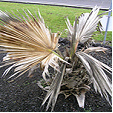 Pritchardi species
Pritchardi species 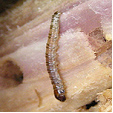 Banana moth larvae
Banana moth larvae
European Pine Shoot Moth (Rhyacionia buoliana) lays eggs on Pinus species during late spring on the new buds and the emerging caterpillars in late summer feed on the shoots causing them to fold and become deformed, eventually dieing. A major problem in the pine forests of the northern hemisphere
Large Grass Yellow Butterfly (Eurema hecabe) is a small attractive yellow butterfly. with a wing span of 40 mm that lays its eggs on the feathery leaves on Acacia species such as A. baileyana, (Cootamundra wattle), A. spectabilis (glory wattle). Other plant foods include Cassia spp, Caesalpinia spp, Senna spp. Albizia julibrissin (silk tree) A. paraserianthes (Albizia) sp Aeschynomene sp (Budda pea), Indigofera australis (Australian indigo's), Sesbania cannabina (yellow pea-bush), Senna surattensis (Glossy shower), Leucaena leucocephala (wild tamarind).
The small lava are up to 15mm long, green with white lateral bands and feed on the leaves at night in small groups, hiding under the leaves during the day. Large infestations may strip trees and require control. The larva of this insect does not feed on grasses. The adults are important pollinators of many Australian native plants. Various sub species of this insect are found through out Asia.
Gypsy Moth (Porthetria dispar) lava is a hairy grey caterpillar that is marked with blue and red dots along its back and can grow to 75mm long. It is capable of defoliating large trees and is a major problem for several species. A major problem in the northern hemisphere.
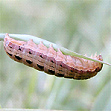 Lawn Armyworm
Lawn Armyworm
Lawn Armyworm (Spodoptera mauritia) is a plump, smooth caterpillar that is darkish brown to black with multiple stripes and pattens along its body. It can grow to 50mm long and tapers from the head. They are gregarious and move around in groups, like an army. If disturbed the larva drop to the ground and curl up, "faking death" The larva pupate in the soil. They are a pest of grasses and monocotyledon crops mainly.
This insect is also found throughout Asia.
Monitoring
Drench a known area with old fashion soap 2L / 1000 cm 2. Note the numbers of larvae emerging.
Oblique-banded Leaf Roller (Choristoneura roseceana) lava feeds on the leaves and forms a nest by drawing the leaf margins together using silk threads. The adult moth is up to 25mm across the wingspan and is reddish brown with three darker brown bands across the wings. This is a problem in the apple growing areas of North America. It feeds on Maples, hawthorns, crab apples, Blackberry (bramble) and raspberries.
Red Humped Caterpillar (Schizura concinna) is a lava has a red head and humps with yellow and black strips on the body. It grows from eggs that were laid on the underside of leaves by the adult greyish brown moth that has a wing span up to 30mm across.
Tailed Emperor Caterpillar (Polyura pyrrhus spp. sempronius) adult is a large butterfly with a wing span up to 110 mm with four long tapering tails and the rear of the wings. The fleshy caterpillar with four obvious backward facing horns on a shield shape head. It is dark green with yellowish bands and transversal stripes over its back and grows up to 80 mm in length.
It is commonly found solitary or in small groups. Found over much on mainland Australia. The adults are attracted to overripe fruits they become drunk on this and so are easy to capture. The larvae feed on many plants including, Acacia baileyana (Cootamundra Wattle, A. spectabilis (Glory wattle), Delonix regia (Poinciana), Cinnamomum camphora (Camphor laurel) Robinia pseudoacacia (Black or false locust) Lagerstroemia indica (Crepe Myrtle), Argyrodendron actinophyllum (Black booyong), Celtis spp (Hackberry), Brachychiton spp (Kurrajongs) Gleditsia triacanthos (Honey locust).
Verbena Moth (Crambodes talidiformis) lays its eggs on the outside of the plant and the small green caterpillar that attacks seed pods by entering and eating the contents. It half emerges while pupating appearing as a small brown bump circled by a black ring. Native to North America
White Tussock Moth (Hemerocampa leucostigma) produces lava that is up to 50mm long. It has a red head with a yellow body that is marked in black and has four tufts of hair. The caterpillars pupate on the branches and the eggs laid by the adult moth overwinter on the trunk and are covered in a white waxy material. They are found on Aesculus species. A pest in North America of Oaks.
Life Cycle
This insect has a Holometabolous life cycle, i.e. it has a larval and a pupal stage.
Distribution of the Pest
Many species are found throughout the world from tropical to temperate regions and most of the adults are capable of by flying
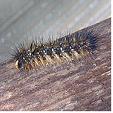 Many hairy caterpillars can be irritating
Many hairy caterpillars can be irritating 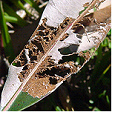 Leaf Skeletonised
Leaf Skeletonised
Period of Activity
Most active during the warmer months from spring to autumn.
.
Damage Caused
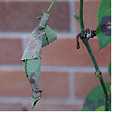 Leaf Rollers
Leaf Rollers
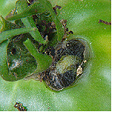 Caterpillar Inside a Tomato
Caterpillar Inside a Tomato
Susceptible Plants
A wide range of native and exotic plants are attacked and can be a major problem in commercial crops or turf grasses. Plants with soft-textured foliage (eg vegetables, some indoor plants) are preferred, but trees and shrubs are commonly attacked.
Malvaceae Abutilon spp, Hibiscus spp and other members of the family are attacked by the castor oil looper, Croton caterpillar (Achaea janata) which feed on leaves. The tip borer Cotton tipworm (Crocidosema plebejana), Rough bollworm (Earias huegeliana) which feeds on young stems, flowers and seeds. A leaf miner (Phyllonorycter spp)
Acer saccharinum and Fagus species are attacked in North America by the Maple Leafcutter (Paraclemensia acerifoliella) that forms a small cocoon in leaves that it skeletonises.
In Australia Case moths and Painted apple moths (Teia anartoides)
Ailanthus altissima is attacked by the Cynthia Moth (Samia cynthia) light green lava, which eats leaves and the Ailanthus Webworm (Atteva aurea) which are olive-brown caterpillars that form web nests in the leaves.
Antirrhinum species are attacked by the Leaf Tier (Udea rubigalis) lava. This caterpillar eats pieces out of leaves and binds them together forming a nest. It is more commonly found in glasshouse culture.
Berberis species may become infested with the Barberry Worm (Omphalocera dentosa). This small caterpillar is black with white spots, up to 14mm long and feeds on young shoots and leaves. It also binds the shoots with a silken thread to form a nest.
Betula species are attacked by the Leaf Skeletonizer (Bucculatrix canadensiella). The small adult moth has brown wings with a whitish underside and its yellow green, 7mm long lava skeletonise the undersides of the leaf turning it brown.
Brachychiton, Senna and feathery-leaved Acacia species are attacked by the Tailed Emperor Caterpillar, particularly in dryer periods.
Catalpa species are attacked Catalpa Sphinx (Ceratomia catalpae). This large yellow and black Caterpillar grows to 76mm long and attacks the leaves. Large infestations can completely stripped a tree and control is carried out by spraying.
Calendula and Canna species are attacked by the Woollybear Caterpillar (Diacrisia virginica) which has yellow and black lines down its body is up to 50mm long and eats the leaves or flower buds. In Canna species the chewed holes tend to be in a straight line across the leaf.
Celtis species are attacked by the Spiny Caterpillar (Nymphalis antiopa) which is reddish, up to 50mm long and feeds on the leaves at the top of branched in groups.
Cheiranthus species are attacked by the Diamond-backed Moth (Plutella maculipennis) lava, which is a small green caterpillar to 14mm long that feeds on the underside of leaves and may form a shot hole appearance. It forms a small cocoon to pupate in and in cooler climates it may be found in glasshouses.
Cotinus, Fraxinus, Betula, Cornus, Crataegus, Aesculus, Tilia, Acer, Quercus and Populus species are susceptible to attacked by the Oblique-banded Leaf Roller (Archips rosaceana)
Iris and Antirrhinum species are attacked by Verbena Moth.
Picea, Abies, Tsuga and Pinus species are attacked by Budworm commonly found in the northern hemisphere.
Populus and Carya species are attacked by the Red Humped Caterpillar which chews the leaves.
Quercus species are attacked by several caterpillars including Saddleback Caterpillar (Sibine stimulea) and Datana Caterpillar (Datana ministra) that feed on the leaves.
Samanea saman is attacked by several caterpillars (Ascalapha odorata, Polydesma indomita and Melipotis indomita). These caterpillars defoliate the tree but cause no long term problems.
Spiraea, Fraxinus, Betula, Cornus, Crateagus, Acer, Quercus and Populus species are attacked by the Oblique-banded Leaf Roller.
Ulmus, Salix, Crateagus, Tilia, Quercus and Populus species, Pseudotsuga menziesii are attacked by the Gypsy Moth (Porthetria dispar).
Ulmus species are attacked by the Spring Cankerworm (Paleacrita vernata), which chews the leaves during spring and the Fall Cankerworm (Alosphila pometaria), which also eats the leaves during autumn. Ulmus species are also attacked by several caterpillars including the lava of the Leopard Moth (Zeuzera pyrina) and the Tussock Moth (Hemerocampa leucostigma).
Cultural Control
Small numbers may be removed by hand and squashed while others species such as the Casuarina Caterpillar drop to the ground when disturbed by hitting with a stick or shaking the plant. On the ground they can be squashed or collected and placed in a bucket of soapy water. All rubbish around plants and glasshouses should be cleared as certain moths overwinter in such places.
Biological Control
There are many natural predators that reduce numbers including birds, lizards, frogs; other predators are wasps, viruses, and fungi.
Chemical Control
The small plant may be sprayed using Pyrethrum-based insecticide to reduce numbers or dusted with an equally environmental friendly chemical. In severe cases crops may be sprayed with Carbaryl.
Note
Always read the label for registration details and direction of use prior to application of any chemicals.
PEST
NAME
Scale Insect
Various Scale Species
ORDER
Hemiptera
Description of the Pest
Generally scales are soft bodied insects that have a hard (armoured) or soft covering to hide under. They have piercing and sucking mouth parts that are attached to the host, feed off sap and soft scales commonly producing sweet honeydew, which in turn attracts sooty mould and ants.
The adult female has a circular or oval covering depending on the species and is up to 8mm across. The first stage (crawlers) hatch and wander around the leaf surface until finding a suitable place to suck sap, normally in colonies and the smaller male is relatively inconspicuous.
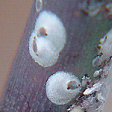 Hard Scale
Hard Scale 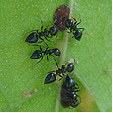 Soft Scale, attending Ants
Soft Scale, attending Ants
Cactus Scale (Diaspis echinocacti) has a circular greyish female and a narrow white male scale and is commonly found on house plants.
Chain Scales (Pulvinaria species) adult females are obvious with large group of eggs that are white or cottony-like, and the tiny young light green scales are flat and oval-shaped up to 2mm long. The legged nymphs are normally arranged from head to tail along the mid rib of the leaf, and may move to a new position to feed. They excrete honeydew and attract sooty mould and are found on Acacia and Acronychia species.
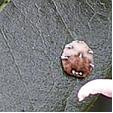 Chinese Wax Scale
Chinese Wax Scale
Chinese Wax Scale (Ceroplastes sinensis) is a domed wax scale that has dark spots around its margin and immature scales form waxy material around there margins.
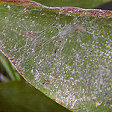 Fern Scale on Aspidistra elatior
Fern Scale on Aspidistra elatior
Fern Scale or Coconut Scale (Pinnaspis aspidistrae) appears as flecks up to 0.15mm long with a white covering over the male congregating on the underside of the fronds on the axils and among the sporangia causing them to turn yellow. Many species of fern are susceptible to infestation.
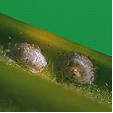
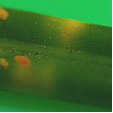 Flat Brown Scale
Flat Brown Scale
Flat Brown Scale (Eucalymnatus tessellates) are light brown up to 0.5mm long, flat and closely attached both sides of the leaf and causing yellowing of the foliage.
Juniper Scale (Diaspis carueli) is tiny and circular, white maturing to grey-black and as it feeds the needles turn yellow and die.
Oleander Scale (Aspidiotus hederae) is a pale yellow circular scale up to 3mm across and is found in dense colonies on the stem or leaves.
Tea-tree Scale (Eriococcus orariensis) are a creamy blue colour normally packed along the branches and are plump and rounded to 4mm across.

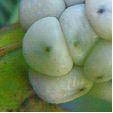 Wattle Tick Scale
Wattle Tick Scale
Tick or Wattle Scale (Cryptes baccatus) adult is domed, blue-slate colour with a leathery covering up to 10mm long. All stages of growth are found in groups of over forty, packed along the stems and normally tended by ants as they produce large amounts of honeydew. A serious pest of Acacia species found inland or coastal from temperate to sub tropical climates and commonly accompanied by Sooty Mould.
Toxic Scale (Hemiberlesia lataniae) is a tiny flat rounded scale up to 0.15mm long and is white to pale pink. It is normally found in colonies on the small branches and twigs of shrubs. It injects a toxic substance into the host as it sucks sap causing the death of the branch.
Wattle Scale (Pseudococcus albizziae) is soft, plump and secrets cotton-like threads. It is not a true scale insect and is simular to mealy bugs. It is reddish-brown up to 0.4mm long and secrets large amounts of honeydew as it sucks sap in colonies along the branches.
Life Cycle
These insects have a Hemimetabolous life cycle, ie. When the immature nymphs resemble the adults.
Appearance of the Pest
All parts of the plant above the soil may be attacked, but normally the stems and leaves and scale tends to favour well-lit positions.
Period of Activity
The nymphs and females are active for most of the year, in warm climates. Once they selected a position they attach and don't move. Normally the winged or wingless males are mobile and only soft scales produce honeydew.
Susceptible Plants
There is a wide range of susceptible plants including citrus, willows, holly, and many ornamentals, such as roses or Paeonia species. It also attacks indoor or glasshouse plants and Australian native plants such as wattles, hakeas, grevilleas and eucalyptus.
Acacia species are attacked by the Tick or Wattle Scale, which infest twigs and small branches and heavy infestations will kill the host plant.
Acer species are attacked by the Cotton Maple Scale (Pulvinaria innumerabilia) which prefers Acer saccharinum. Nymphs first attack the leaves and the brown adult scale is covered in a woolly mass up to 14mm across, normally found on the underside of the stems and twigs.
Acmena smithii, Melaleuca, Syzygium and Pittosporum species are attacked by the Chinese Wax Scale.
Aesculus species are attacked by several scale insects including the Walnut Scale (Aspidiotus juglans-regiae) which is saucer-shaped and attacks the main trunks.
Agave species are susceptible to several types of scale including (Aspidiotus nerii), (Aonidiella aurantii) and (Pinnaspis strachani), but generally do not require control.
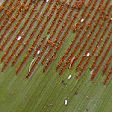 Asplenium australasicum
Asplenium australasicum
Asplenium australasicum is susceptible to Coconut Scale or Fern Scale (Pinnaspis aspidistrae). It is normally found on the under side of the fronds. Small infestations cause little damage.
Bougainvillea species may be attacked by the soft scale (Coccus hesperidum) outdoors or under glass.
Calluna and Vaccinium species are attacked by the Oyster Shell Scale (Lepidosaphes ulmi).
Camellia species may be attacked by the Florida Red Scale (Chrysomphalus aonidum), which is small, circular and black and is found firmly attached to the underside of the leaf along the veins. On inspection after removing the scale the insect has a pale yellow body. Camellias are also attacked by a large variety of scale insects including Tea Scale and Camellia Scale.
Carpinus species may be attacked by the scale (Phenacoccus acericola). It is found on the underside of the leaves forming a white cotton-like clump along the veins.
Casuarina and Allocasuarina species may be attacked by the Casuarina Scale (Frenchia casuarinae), a black hard scale that is upright to 4mm with a pinkish body. During attachment the surrounding tissue swells up and in time can, form galls. This weakens the wood and in severe infestations may kill the tree.
Cotoneaster species are attacked by up to four species of scale including the Oyster Shell Scale (Lepidosaphes ulmi).
Cupressus species are attacked by Bark Scale (Ehrhornia cupressi) is pink and covered in white wax. Heavy infestations cause the leaves to turn yellow or reddish.
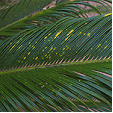 Flat Brown Scale on Cycas revoluta
Flat Brown Scale on Cycas revoluta
Cycads, palms and some species of Callistemon are attacked by the Flat Brown Scale.
Erica species are attacked by several species of scale including, Greedy, Oleander and Oystershell scale.
Jasminum species can be infested with up to twelve types of scale.
Juniperus x media and other conifer species are attacked by the Juniper Scale.
Leptospermum species are attacked by the Tea-tree Scale which produces ample honey dew that promotes sooty mould.
Palm and Fern species are susceptible to attack by the Coconut Scale or Fern Scale (Pinnaspis aspidistrae) which infests the underside of the leaves. They are also hosts for many other scale species such as red, cottony cushion and tea scale.
Pinus species are attacked by several species of scale including the Pine Tortoise Scale (Toumeyella numismaticum) and the Red Pine Scale (Matsucoccus resinosae).
Polygonum odoratum is attacked by a small brown scale.

Sorbus aucuparia is attacked by a five species of scale insect, including Black Cottony Maple, San Jose and Scurfy. Generally they suck on the sap of the new growth and leaves.
Strelitzia species are attacked by the Greedy Scale (Aspidiotus camelliae).
Damage Caused
Leaves become yellow and are shed prematurely and there may be twig or stem die-back. When the infestation occurs on fruit, the fruit is small and its skin becomes pitted and cracked. Small trees and saplings that are heavily infested may be seriously damaged or die. Sooty mould can cover fruit or leaves causing a secondary problem.
Cactus Scale can completely cover the host cactus sucking sap and causing it to die.
Cultural Control
Dead or damaged parts of the plant should be removed and destroyed including fallen fruit. Small infestations may be removed by hand or squashed on the stems. Healthy plants are less susceptible to attack, so maintain vigour of the plant and avoid using high-nitrogen fertiliser that produces excessive soft young growth.
When pruning susceptible plants paint the cuts with antifungal sealant paint as scale insects are attracted to the sweet smell of the sap. This will reduce the infection rate of the plant.
Biological Control
Natural predators such as parasitic wasps may reduce numbers of active nymphs; parasitic wasps are bred commercially in some areas for this purpose. It should be noted, however, that wasps would avoid dusty conditions.
Other predators that assist in control are assassin bugs, ladybirds, lacewings, hover flies and scale eating caterpillars. A variety of birds also attack scales.
The control of ants that transport aphid from one host to another also reduces infestation and can be carried out by applying at least three greased bandages 5mm apart around the stem or trunk of the plant.
Chemical Control
Spray the entire plant with dilute white oil solution; a follow-up spray may be required after four weeks, for heavy infestations. Spraying of chemicals will also kill of natural predators and in some cases the secondary scale infestation is more prolific especially when using copper based chemicals.
Some chemical controls, such as methidathion, are available - please seek advice from your local nursery as to the suitable product for your area.
Note
Always read the label for registration details and direction of use prior to application of any chemicals.
PEST
NAME
Leaf Hopper (General)
Various Leaf Hopper Species
ORDER
Hemiptera
FAMILY
Eurytomidae
Description of the Pest
Generally hopper grows up to 15mm in length, with "A"-shaped folded wings that give it a characteristic triangular cross-section. The adults often have bright coloured markings and the nymphs conjugate in colonies. Adults can fly but will hop away immediately if disturbed and both nymphs and mature hoppers have piercing and sucking mouth parts.
The Passion Vine Hopper (Scolypopa australis) has clear triangular wings that have brown margins and black bands. The nymphs are wingless and white with tufts of hair on the end of the abdomen.
The Green Leaf Hopper (siphanta acuta) looks triangular with its steeply folded wings and can grow to 10mm long. The adults are generally a solitary feeder but the nymphs congregate on shoots.
Appearance and Distribution of the Pest
The adults and nymphs are present throughout the year in tropical to warm temperate regions and are dispersed by flying.
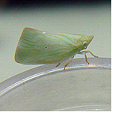

Life Cycle
These insects have a Hemimetabolous life cycle, ie. When the immature nymphs resemble the adults.
Females deposit eggs in slits they make in the bark or on the leaves of the host, and several generations may appear annually on the same plant.
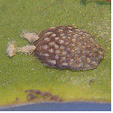 Egg and Nymph
Egg and Nymph 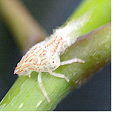
Damage Caused
Nymphs and adults are gregarious, and both stages may be found on host plants at the same time. If large numbers attack young new growth, sucking sap from leaf petioles and young stems, the host plant may become stressed. Severe infestations may weaken and eventually kill the plant with dieback and distorted leaves.
The nymphs exude a sweet secretion, which is attractive to ants that attend and protect the colony. The honeydew also causes sooty mould to occur as a secondary problem. Some species produce toxic saliva that kills the effected plant tissue; other species carry plant viruses.
Susceptible Plants
Most Eucalyptus, Acacia and Casuarina species are attacked by a variety of leafhoppers. Many other Australian native and ornamental plants are attacked.
Acer species are attacked by the leaf hopper (Alebra albostriella) which lays eggs under the bark causing minor swelling. Acer platanoides is particularly venerable.
Callistephus and Aster species are attacked by the Leaf Hopper (Macrosteles fascifrons) that generally causes little harm to the plant but transmits Yellow Disease, a viral infection.
Fern species are attacked by several types of leaf hopper, particularly the Passion Vine Hopper (Scolypopa australis). New fronds become deformed or misshapen as the insect sucks the sap causing dead patches to appear.
Parthenocissus species are attacked by the Green Leaf Hopper.
Rosa species are attacked by the Rose Leaf-hopper (Edwardsiana rosae), nymphs feed on the underside of leaves causing white blotches.
Sorbus aucuparia is attacked by the Japanese Leaf Hopper (Orientus ishidae) which causes the leaves to form a brown blotches with yellowish margins.
Cultural Control
Improving the culture of the host species may assist in maintaining vigorous growth, to minimise shock from infestations. It may be possible to remove them by hand, from young trees, using a small butterfly net if you are lucky.
Biological Control
Controlled by natural predation and the Green Leaf Hopper causes little harm and control is unnecessary.
Chemical Control
Under normal circumstances, it is impractical and unnecessary to treat mature trees however, hoppers on young plants may be treated with a contact insecticide. Note
Always read the label for registration details and direction of use prior to application of any chemicals.
DISEASE
NAME
Bacterial Rot
Various Bacterial Species
Description
Bacterial problem associated with water soaked strips on the leaves, stem, roots, fruit or flower. Bacterial wilts produce causative slime that clogs the water-conductive tissue of a plant.
Symptoms
Bacterial Blight (Pseudomonas mori) forms water soaked spots on the leaves and shoots, becoming sunken and turning black causing the leaves and twigs to wilt and die.
There is also a Bacterial Blight (Pseudomonas syringae pv pisi) that infects legumes during humid weather with water soaked spots on the leaves and stems near the base. The spots become dark and as the stem shrivels, yellow lesions appear. Leaves and fruit pods turn brown and die.
Bacterial Leaf Spot (Pseudomonas viburni) forms wet spots that enlarge becoming brown and sunken. These spots can be seen on the leaves and young stems and the bacteria overwinter in buds or in cankers. It is found on Viburnum species.
Bacterial Wilt (Xanthomonas species) infects palms causing the lower fronds to wilt then turn grey-brown and die. This is followed by the crown becoming spongy (rotted) attacking the vascular tissues and eventually causing the collapse of the crown. There is also a Bacterial Leaf Spot (Xanthomonas species) that causes spots on leaves with water-soaked margins and is found on Alocasia species.
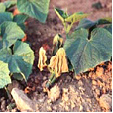 Bacterial Wilt
Bacterial Wilt
Bacterial Wilt (Pseudomonas solancearum biovar 1 and 3). This disease initially turns the youngest leaves pail-green to yellow; they then wilt turn brown and die. It eventually affects the entire plant and is found on Heliconia species.
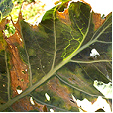
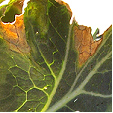 Black Rot or Bacterial Wilt
Black Rot or Bacterial Wilt
Black Rot or Bacterial Wilt (Xanthomonas campestris) is a bacteria rot that infects the leaves and seedlings of Cruciferous vegetables causing 'V' shaped pale yellow blotches to appear, normally infection occurs along the margin of the leaf or through damaged areas of the leaf. It also causes the flower head to become stunted and the veins or water conducting tubes in the leaves and stems to turn brown or blackish. Heavy infections cause the plant to wilt and die.
Bud Rot (Xanthomonas cannae) infects young leaves and flower buds of Canna species, killing them. Small whitish spots appear as the leaves or buds open, these enlarge then run together turning black. The symptoms also extend to the petioles and stems forming yellowish water soaked areas and the bacterium overwinters in the rhizomes.
Halo Blight of Beans (Pseudomonas syringae pv phaseolicola) forms water soaked or greasy angular spots on the pods or stems of the host. This causes the plants to yellow and become stunted. During humid weather a white slime is exuded from the damaged areas.
Soft Rot (Pecotbacterium carotovorum) affects bulbs, initially stops flowers from blooming or forming correctly. These flowers are shed, and the plant rots at the base causing it to collapse. On inspection of the bulbs a white foul smelling viscous smell is associated with a soft rot.
Wetwood (Erwinia nimipressuralis) causes wilting and branch dieback in Ulmus species. The wood forms dark water soaked areas with no obvious streaking in the outer sapwood.
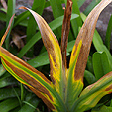 Yellow Rot in Iris
Yellow Rot in Iris
Yellow Rot (Xanthomonas hyacinthi) is a bacterial disease infects the cell walls of the leaf, stem and bulbs and caused yellowish water soaked areas to appear. These areas become brown and shrivel, or pockets of rot appear, soon engulfing the entire bulb. The disease may start from the leaf down or from the bulb up infecting the whole plant. A cross section reveals vascular tissue that is choked with yellowish slime. Infected plants soon brown off, collapse and die.
Source and Dispersal
The bacterium is found in infected plant material and not necessarily the soil and is spread by splashing water, wind or infected stock.
Favoured Conditions
It prefers warm moist conditions normally during spring.
Affected Plants
These bacteria attack many plants including; onions, Hyacinth species and its varieties, this can be a major problem in bulb nurseries.
Vegetables such as potatoes are also infected by blight which forms dark brownish spots on the leaves that become larger, eventually killing them and followed by lesions on the stems. The roots are infected by falling spores and peas suffer from a bacterial blight that forms spongy leaves with dark brown edges. The leaves and stem shrivel and die.
 Strelitzia nicolai
Strelitzia nicolai
Archontophoenix and Strelitzia species are susceptible to the Bacterial Wilt (Pseudomonas solanacearum). The leaves become yellowish and brownish along the margins causes the fronds to wilt and dry out. The vascular tissue in the stems then becomes blackish and the plant dies prematurely.
Berberis species are infected by the Bacterial Leaf Spot (Pseudomonas berberidis) forming irregular dark green water soaked areas that turn purplish brown. It also infects young shoots and petioles or damaged areas.
Bougainvillea and Limonium species are infected by the Bacterial Leaf Spot (Pseudomonas andropogonis) which forms orange angular spots that are lighter in the centre and cause the leaves to fall prematurely. It is most common in tropical regions.
Caryota mitis (Clumping Fish Tail Palm) is infected by the Bacterial Blight (Pseudomonas avenea). The symptoms include water soaked translucent areas along the leaf veins that mature to brown then black with a chlorotic halo that is up to 2 mm wide by 50 mm long. Leaves of all ages are infected and immature leaves are more severely infected.
Control methods include eliminating overhead watering, removing infected foliage and improve air circulation around the plant.
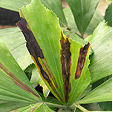 Caryota mitis
Caryota mitis
Cheiranthus species and other plants in the Brassicaceae family are infected by the Bacterial Wilt (Xanthomonas campertris) causing the leaves to wilt, turn yellow and die. It also stunts the inflorescence and turns the phloem and xylem blackish. Other plants that are infected include, Arabis, Armoracia, Aubrieta, Brassica, Hesperis, Iberis, Lobularia and Mathiola species.
Corylus species are infected by Blight ((Xanthomonas corylina) that attacks the leaves and branches.
Delphinium species are infected by several leaf spots including the bacterial disease Black Leaf Spot (Pseudomonas delphinii) which produces irregular tar-like spots on the upper surface of the leaf with corresponding brownish areas on the underside. This infection may extent down the petiole to the twigs. It normally occurs during cool weather affecting the lower leaves first.
Dianthus species are infected by the Bacterial Wilt (Pseudomonas caryophylli) which turns the leaves greyish, then yellowish before dieing. Yellowish streaks are also seen on the stems.
Dieffenbachia species are infected by two Bacterial Leaf Spots (Erwinia species) and (Xanthomonas campestris pv. dieffenbachiae). Both form yellowish spots that turn brown on the leaves that have water-soaked margins.
Eschscholtzia species are infected bt the Bacterial Blight (Xanthomonas papavericola) which forms tiny black spots that are water soaked and may be ringed.
Euphorbia pulcherrima is infected by Bacterial Canker (Corynebacterium poinsettiae) which forms streaks on the green stems that are water-soaked. The leaves may also be affected producing spots or blotches.
Gladiolus, Crocus and Freesia species are susceptible to Bacterial Scab (Pseudomonas marginata). This disease attacks the corms by forming slightly raised yellowish lesions that develops a raised rim with a soft sunken centre, producing bacterial exudate. It also infects the leaves with small reddish spots appearing towards the lower part. These spots merge and destroy the basic cell structure (parenchyma tissue) in the petioles causing the leaves to fold downwards, eventually killing the plant.
Hedera helix is susceptible to the Bacterial Leaf Spot or Stem Canker (Xanthomonas hederae). This infection commences with pale green water soaked spots or areas appearing on the leaves. These areas than become brown-black and dry with reddish margins, eventually engulfing the leaf causing it to shrivel. The bacterium then extends along the twigs and into the stems causing cankers. Several Fungal leaf spots develop simular symptoms and may be difficult to distinguish the difference. Generally avoid high humid temperatures and water plants at the base.
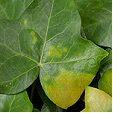
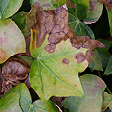
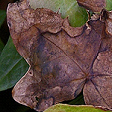 Hedera helix
Hedera helix
Morus species are infected by Bacterial Blight (Pseudomonas mori).
Orchids such as Cattleya, Cymbidium, Cypripedium, Dendrobium, Epidendrum, Oncidium, Paphiopedilum, Phalaenopsis and Zygopetalum species are infected by Bacterial Brown Rot (Pseudomonas cattleya) which forms water-soaked leaf spots that turn brown. Phalaenopsis species are particularly susceptible.
Caryota species are susceptible to Bacterial Leaf Blight (Pseudomonas albopercipitans). This disease forms elongated water soaked areas on the fronds that are translucent at first becoming blackish.
Roystonea regia, Cocos nucifera and Phaseolus species are infected by Bacterial Wilt (Xanthomonas species).
Tropaeolum species are infected by Bacterial Leaf Spot (Pseudomonas aptata) forming spots and rotting the leaves. They are also infected by the Bacterial Wilt (Pseudomonas solanacearum) which gains access through damaged roots or through the stomates, causing yellowing, wilting and the death of the plant.
Zinnia species are attacked by Bacterial Wilt (Pseudomonas solanacearum).
Non-chemical Control
Remove and destroy any infected plants. As a preventive measure cultivate the surrounding soil to improve drainage, aeration and minimise weed growth. Do not over water and allow the soil surface to dry before rewatering. When handling the plants pick a dry period and take care to minimise damage.
At first sigh of infection the plant should be removed and disposed off and avoid replanting susceptible vegetables such as peas for up to three years.
Chemical Control
There is no satisfactory chemical control. It is important to take preventive measures.
Note
Always read the label for registration details and direction of use prior to application of any chemicals.
DISEASE
NAME
Fungi (General)
Various Fungal species
Description
A fungus is a plant that lacks chlorophyll and conductive tissue. Generally they are made up of branched threads called 'hyphae' and collectively form a vegetative body called 'mycelium'. The fungus is small but the fruiting bodies can become very large up to 600mm across such as bracket fungi or mushrooms. Common fungi are mould and mildews. problem that attacks the roots causing them to rot.
Fungus can reproduce many ways but primarily it is asexually, simular to cuttings of a plant and often occurs with minute portions of the mycelium (spores) separating. The spores can be arranged in a structure such as a sporangia or pycnidia or develop without an enclosed structure called a "conidia". Either way the fungus propagates very rapidly. Sexually reproduction occurs when two nuclei unite and form sexual fruiting bodies (zygospore).
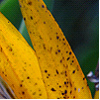 Strelitzia reginae flower
Strelitzia reginae flower
Symptoms
Fungus attacks all the above or below ground level parts of the plant living within the tissue of the plant and are very small and not normally detected until the fruiting body appears. However parasitic types such as powdery mildew or rust are visible on the outer surface of the plant.
Fungi hyphae may be divided by cross walls and known as "septate" while others with no cross walls are known as "nonseptate". These are the fungi responsible for cell leakage as in rot.
Back Mold (Chalariopsis thielavioides) affects understocks of grafted Rosa species by inhibiting the development of callus. It is whitish-grey maturing to black and can be found in the pith of the rose stem.
Black Root Rot (Chalara elegans).This recently introduced fungal disease in Australia (1993) affect plants by blackening the root systems and turning leaves yellow or purple. It is difficult to identify specifically as other pathogenic root diseases and nutritional deficiencies have simular characteristics.
The asexual spores are dispersed by wind or water. It is also transmitted on insects and in contaminated growing media or plants preferring humid moist conditions.
This fungus affects a wide range of ornamental plants including; annuals, perennials and shrubs. Examples are Begonia, Boronia, Camellia, Cyclamen, Fuchsia, Gerbera, Grevillea, Impatiens, Pansy, Petunia, Rosa species and Snapdragon.
Black Stem Rot (Pythium splendens) normally is a rot that occurs in cuttings turning the stem progressively black and shrunken. The leaves fall and the plant becomes stunted, eventually dieing.
Bleeding Necrosis (Botyosphaeria ribis) attacks and kills the inner wood causing the bark to split open and bleed sap giving it an oily appearance.
Blight (Endothia parasitica) is a serious pest of Castanea species, entering the twigs and small branches, and then progressively travelling throughout the tree killing it. It may form cankers on the base of the trunk or in the dead branches above with the amber coloured fruiting bodies pushing there way through the bark.
Copper Web ((Rhizoctonia crocorum). This fungal disease appears in defined patches causing the corms in the centre to become a black powdery mass. Corms on the outer ring of the patch that are partially infected forming a felty mass of violet threads on the corm scales. These threads extend into the soil and large sclerotia forms in the soil and on the corms. Healthy corms become infected from contaminated soil that contains mycelium and sclerotia.
Dry Rot (Phyllosticta concave) forms small circular spots that increase to a diameter of 30mm, and then becomes sunken as the cells collapse. The infected area develops minute black fruiting bodies.
Dutch Elm Disease (Ceratocystis ulmi) is a serious fungal problem of Ulmus species that initially causes yellowing then wilting of the leaves that turn brown and die. This may be seen on certain branches of the tree and on inspection under the bark the sapwood reveals brown streaks. A cross section of the affected branch displays round spots that are dark brown. This infection normally spreads quickly throughout, killing the tree in one to two seasons.
Dieback in Camellia (Glomerella cingulate) is a pathogenic fungus that infecting existing wounds such as leaf scars or mechanical damage, forming a sunken area (canker) that spreads around the stem causing die back. The affected plant has new shoots that are brown-black and the tips curl, forming a 'Shepard's Crook' appearance. The leaves also die but are persistent on the plant and the spores are found in soil or on other infected plants.
Curvularia Leaf Spot (Curvularia species) in Turf Grass. This is normally a secondary weak fungal infection that forms spots on the leaves that lengthens turning the leaves greyish. The leaf shrivels then dies and infected areas appear as weak patches in the turf. Preventive measures include minimising leaf wetness and excessive use of nitrogen fertiliser.
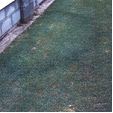 Fairy Rings Blue Couch
Fairy Rings Blue Couch 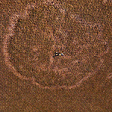
Fairy Rings are a fungal problem in Turf Grass and is caused by several species including (Lycoperdon species), (Marasmius species) and (Tricholoma species). Rings appear in the turf as fruiting bodies or dead grass and as lush green foliage. The mycelia expand radially in the turf feeding on soil nutrients and organic matter with water present.
Under severs conditions the mycelia consume all available nutrients resulting in the death of the turf. Lush turf can result from a less developed infection, where the decomposing hyphal releases nitrogen. This available nitrogen may be beneficial to the turf but some forms of nitrogen are detrimental.
Leaf Blister (Taphrina coerulescens) appears as yellowish circular raised areas on the upper side and depressions on the underside of leaves, up to 15mm across. As the fungus spreads the leaf dies but remains attached to the tree and this infection is commonly found on Quercus species..
Leaf Blotch (Guignardia aesculi) forms small or large water soaked spots that are reddish with a bright yellow margin and form black fruiting bodies in the centre. The affected leaf and petiole have a scorched appearance before falling, found on Aesculus species
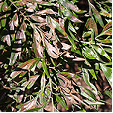 Grevillea robusta
Grevillea robusta 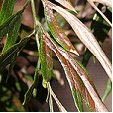 Leaf Scorch
Leaf Scorch
Leaf Scorch (Verrucispora proteacearum) is a fungal disease that infects leaves causing large parts of the leaf to turn grey-brown, giving the appearance that it has been singed by fire. Black fruiting bodies appear on the affected areas and the leaf soon withers then dies. New, mature leaves are affected during very wet periods towards the end of the branches and Grevillea and Hakea species are susceptible.
Melting Out (Helminthosporium vegans) forms bluish black spots with straw coloured centres on the leaves and may be found on the sheath, encircling it causing Foot Rot. It infects grasses particularly Poa pratensis. There is another fungus that is simular Helminthosporium Blight (Helminthosporium dictyoides) that infects Poa, Festuca and Agrostis species.
Pad decay (Aspergilus alliaceus) infects Cereus and Opuntia species and occurs at during periods of high temperature. The yellow spores at the epidermal layer through wounds and germinate on mass causing the area to become soft and spongy. An anthracnose called Shot Hole is a similar forming brownish spots the turn grey, and then black destroying pads. Control methods include physically removing damaged pads and allowing the Sun to heal wounds.
Potato Gangrene (Phoma foveate) is a soil borne fungus that infects the roots during harvest primarly through wounds and develops during storage. The potatoes rot from the inside forming rounded depressions on the surface and have a strong odour of rotten fish.
Root Rot Fungi (Phymatotrichum omnivorum) and (Pellicularia filamentosa) cause the roots to rot and the plant suddenly wilts then dies.
Root Rot (Pythium debaryanum) forms water soaked dark brown streaks that affect all parts of the plant causing wilting then dieing. It infects Ranunculus species, it also infects cactus species by forming brown spotting and wilting that appears at the base of the plant then extends towards the top. It quickly spreads from plant to plant in collections and is controlled by avoiding over watering, excessive humidity and are using a sterilised soil when potting up.
This fungus also is responsible for damping off of seedlings in a glasshouse environment.
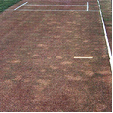 Spring Dead Spot
Spring Dead Spot 
Spring Dead Spot (Leptosphaeri species) is a fungal disease that infects Couch Grass. It first appears during autumn as pale bleaches areas up to 500mm (20in) wide and persists throughout winter. In spring the affected areas do not recover or recover slowly and on inspection the roots or rhizomes are rotted. Runners from the surrounding healthy turf will help with recovery and all signs of the problem disappear by mid summer.
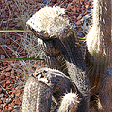 Cactus species
Cactus species 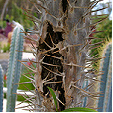 Pachypodium species
Pachypodium species
Stem Rot (Helminthosporium cactivorum) forms well defined yellow lesions that mature into soft dark brown rot. It commonly infects Cactus species entering through the stomates or wounds. Heavily infected plants collapse and die.
Stem Rot or Basal Rot (Pellicularia rolfsii) is a soil borne fungus that infects the stem root junction and extends into the leaves. In orchids the leaves become discoloured, dry and detach from the base which is covered in a fungal growth that produces sclerotia. The sclerotia is whitish to yellow then becoming dark brown and can be viable for up to four years.
White Mold (Ramularia desta f. odorati) occurs on both sides of the leaf and looks simular to powdery mildew but forms faint dull, reddish brown elongated spots on the leaf that may be depressed or along the margin where they have a watery appearance. Tufts of hyphae develop in the stomates.
Wilt (Ceratocystis fagacearum) causes leaves to curl then turn brown and the sap wood may also turn brown or black. Heavy infection may kill a tree within two seasons and is found on Quercus species and other ornamental trees.
Witches Broom may be a fungal problem that causes a proliferation of small axillary shoots to appear at the end of the branches. Little is known about this problem, though it affects a wide range of plants including Eucalyptus, Leptospermum and Pinus species.
Source and Dispersal
Fungus is found in the soil or on other infected plants and after releasing the spores, they are dispersed by wind or are transmitted in infected stock, insects and with splashing water.
Wilt is transmitted by infected root stocks, several species of insect and contaminated tools.
Dutch Elm Disease is transmitted by bark beetles such as (Scolytus multistriatus) and (Hylurgopinus rufipes). These beetles deposit eggs in the sapwood where the lava tunnel and pupate. The emerging beetles tunnel the bark and carry the fungus to fresh feeding sites on the tree. Infected beetles may also be transported to fresh sites in waist material.
Favoured Conditions
Prefers cool moist conditions with temperatures from 10º to 25ºC and is more common from autumn to spring when it is wet.
Affected Plants
A wide range of plants and all parts can be infected by various fungal diseases. Bleeding Necrosis is found in Liquidambar species and Stem Rot or Dry Rot infects Cactus species such as Opuntia and Pelargonium.
Abies species are infected by several fungi that cause Leaf Cast which turn the needles yellow to brown then fall prematurely.
Abutilon species are infected by the Stem Rot (Macrophomina phaseolin) affecting the lower stems and is not commonly seen.
Achillea, Cuphea, Leucanthemum, Euphorbia species are infected by the Stem Rot (Pellicularia filamentosa) which enters through the roots and rots the base of the stem.
Alternanthera species are infected by the Leaf Blight (Phyllosticta amaranthi) which forms small brown spots on the leaves causing them to curl and die.
Aloe, Astrophytum, Copiapoa, Echinocactus, Espostoa, Ferocactus, Gymnocalycium, Kalanchoe and Schlumbergerera species are infected by Bipolaris Stem Rot (Bipolaris cactivora). This infection affects many cacti species causing rot in the stems with a blackish appearance.
Amelanchler is affected by the Witches Broom (Apiosporina collinsii).
Antirrhinum species are infected by the Blight (Phyllosticta antirrhini) that forms light brown spots on the upper-side of the leaf and on the stem. As the spots enlarge they turn greyish with black fruiting bodies in the centre, then become brown and killing the affected areas.
Begonia species are infected by the Stem Rot (Pythium ultimum) turning stems black then becoming soft and causing the plant to collapse. This is the same fungus that causes Damping-off.
Betula species are affected by the Leaf Blister (Taphrina bacteriosperma) which curls the leaves and forms reddish blisters.
Chamaedorea and other cain-like species are infected with Gliocladium Stem Rot (Gliocladium vermoseni) which forms a dark basil stem rot generally on damaged plants and produces orange-pink spores. The mature leaves are first affected and eventually the stems or cains rot and die.
Crocus and Gladiolus species are infected by the Dry Rot (Stromatinia gladioli), which causes lesions on the corms and rots the leaf sheath.
Crocus, Iris, Tulipa, and Narcissus species are infected Copper Web ((Rhizoctonia crocorum).
Dianthus species are infected by Phialophora Wilt (Phialophora cinerescens) that causes the leaves to fade and plants to wilt. There is obvious vascular discoloration which is very dark. It is not found in Australia.
Erythrina x sykesii may be infected by the Root Rot Fungi (Phymatotrichum omnivorum).
Fern species are infected by Tip Blight (Phyllosticta pteridis). This blight produces ash-grey spots with purple brown margins and the fruiting bodies appear as black pimple like spots. It is transmitted by air or moisture and in infected fronds become brown and die. Control methods include sprang fungicide on leaves or reducing humidity and avoid wetting the fronds.
Forsythia species are infected by Stem Gall (Phomopsis species). It forms rounded growths along the stems causing them to die and look unsightly.
Gladiolus species are infected by Penicillium Rot of Corms (Penicillium gladioli). This disease forms deeply sunken reddish brown areas that become corky and produce a greenish fungal growth.
Hedera species are susceptible to several Fungal Leaf Spots including (Glomerella cingulate), (Phyllosticta concentrica) and (Ramularia hedericola). All of which cause yellowish spots that develop into dry brown blotches that kill the leaf.
Larix species are susceptible to Leaf Cast (Hypodermella laricis). This fungus attacks the needles and spur shoots turning them yellow at first then brown after which small black fruiting bodies appear on the leaves during winter.
There are several other fungi including (Cladosporium species) and (Lophodermium laricis) cause leaf blight or leaf casts.
Orchids such as Cattleya, Cymbidium, Cypripedium, Dendrobium, Epidendrum, Oncidium, Paphiopedilum, Phalaenopsis and Zygopetalum species are infected by Phomopsis Rot (Phomopsis species). This fungal problem forms a firm brown rot that appears on the leaves, pseudobulbs and rhizomes. The affected areas have yellow margins and the centre is covered in tiny black specks (fruiting bodies). Cattleya species are particularly susceptible. These plants are also infected by Psudobulb Rot (Mycolleptodiscus coloratus implicated). Dark spots appear on the pseudobulbs eventually causing extensive rot and killing the bulb.
Palms are infected by the fungus Butt Rot (Ganoderma sulcatum). The fungus entered the lower trunk normally as a result of mechanical damage (lawn mower). Symptoms include stunting of new growth and yellowing of the lower leaves. Fruiting bodies become evident at the base of the trunk. There is no effective control method and replanting in infected soil should be avoided.
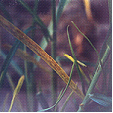 Kikuyu Yellows
Kikuyu Yellows 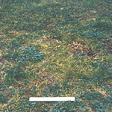
Pennisetum clandestinum (Kikuyu) is susceptible to Kikuyu Yellows (Verrucalvus flavofaciens), thisis a water mould that infects the roots and causes them to rot. The infection extends up the stem and onto the leaves with yellow discolouration and can be limited to a small or large area up to 1m (3ft) wide.
It is found in warm temperate to sub tropical regions and dispersed in infected soil or plant material. There is no chemical control, nitrogen fertiliser masks the symptoms and complete fertiliser encourages stronger roots to fight the disease.
Pittosporum, Antirrhinum, Aquilegia, Echinops and Orchid species are infected by the Stem Rot or Basal Rot (Pellicularia rolfsii) commonly in the northern hemisphere and preferring humid glasshouse conditions.
Solidago species are infected by the fungal Scab (Elsinoe solidaginis) which covers the leaves and stunts the growth of the plant. Young plants may be killed.
Trillium species are infected by the stem rot (Pellicularia rolfsii) and ( Ciborinia trillii). This normally occurs in wet soils and is detrimental to the plants life.
Tsuga species are infected by Sapwood Rot or Butt Rot (Ganoderma lucidum) and (Coniophora puteana), which attacks the sapwood close to the bark, towards the base of the tree. Commonly killing the host.
Tulipa species are affected Blue Mold (Penicillium species) and the fungus (Rhizopus stolonifer) causing rot in the bulbs.
Vinca species are infected by the soil born Root Rot (Pellicularia filamentosa) which rots the stems and roots.
Viola species may be infected with the Scab (Sphaceloma violae) which attacks all parts of the plant including the seed capsule forming yellowish spots that turn brown and in leaves fall out. Stems and petioles can be girdled killing the upper part.
Viola species are also infected with the Stem Rot (Myrothecium roridum) which attacks the stems at ground level causing them to become dry and brittle. The leaves show symptoms by turning purplish-black and this fungus also infects Alcea and Antirrhinum species.
Non-chemical Control
Generally remove and destroy any infected plants or plant parts, when replanting, avoid using susceptible species for 3 years. When growing crops space the plants to reduce the humidity and airflow and cultivate the soil to increase the drainage. Remove weed growth from around the susceptible plants.
Avoid over watering the surrounding soil which encourages fungal development. In the case of trees remove any infected branches and heavily infected trees should be cut down and removed. This infected material should be disposed or burnt. Damaged trees should have the wounds dressed and sealed as a preventative measure particularly for Dieback in Camellia.
Deter Potato Gangrene by planting clean stock and be careful not to damage the crop when weeding. When harvesting the tubers choose a dryer period and be careful not to damage them.

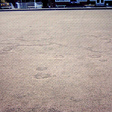 Fairy Rings
Fairy Rings
Fairy Rings in Turf are difficult to control and may appear or disappear sporadically. Cultural practice such as minimal thatch build-up, regular aeration and a reduction of organic matter spread on the turf will reduce infection.
Chemical Control
No suitable fungicides available, though drenching or spraying the soil with the fungicide dichloran helps control soil born fungi.
Note
Always read the label for registration details and direction of use prior to application of any chemicals.
DISEASE
NAME
Canker (General)
Various Canker Species
Description
This is a fungal problem that enters the plant through wounds causing dieback of twigs and stems.
Symptoms
The stems become discoloured (pale brown) usually from a pruned point, working its way down the stem and normally intersecting or surrounded with live cambium. The bark splits or cracks, foliage dies and infected areas can develop tiny black fruiting bodies. Heavy infected plants eventually die, though certain varieties are resistant halting the spread of the infection.

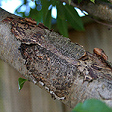
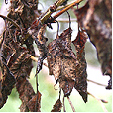
Black Canker (Phyaslospora miyabeana) forms dark brown spots with concentric rings on the upper leaf surface and grey spots on the stems. The tiny black fruiting bodies develop in the stem lesions. It is found on Salix species and persistent attacks will kill the tree.
The Canker (Cytospora valsa) causes the browning and death of branches in Picea abies and Picea pungens. This infection occurs normally from the base of the tree with infected needles falling, and white resinous patches appearing on the bark accompanied by cankers with tiny black fruiting bodies.
The Canker (Corynneum cardinale) is a casual fungus that invades wounds and infects living bark and associated cambium turning the foliage yellowish. As it spreads it girdles the branch killing it and ultimately the top of the tree dies out. Cankers eventually form in the trunk and ooze resin. It is found on Cypress.
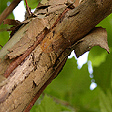 Platanus x hybrida
Platanus x hybrida
Cankerstain (Ceratocystis fimbriata f. platani) forms sunken cankers on the trunk and large limbs forming longitudinal cracks and roughened bark. Infected areas form callus around the margins which dies off and when cut open, dark coloured streaks are revealed extending to the central pith. These streaks then radiate out into uninfected wood resulting in the thinning of the crown and producing unusual small leaves. It is normally transmitted through poor tree surgery techniques and infected tools.
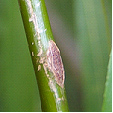 Cytospora Canker
Cytospora Canker
Cytospora Canker (Cytospora chrysosperma) is a casual fungus that infects the young twigs, then moving to the stems, branches and trunk causing brown sunken areas to appear that is covered in red pustules. The fungus tends to attack trees that are in poor health. Control requires the removal of infected branches and improved culture to regain the plants vigour. Sorbus aucuparia, Salix and Popular species are susceptible.
 Cypress Canker
Cypress Canker
Cypress Canker (Seiridium species) enters the plant through wounds or through insect damage causes the bark to spread revealing brown powdery spores that are accompanied by oozing resin. The canker eventually girdles the branch or trunk causing ringbarking and the death of the plant.
Nectria Canker (Nectria Cinnabarina) forms cankers on the twigs and small branches producing red fruiting bodies and eventually killing the tree. It is found in many parts of the world infecting a range of trees including hardwoods.
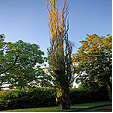
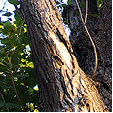
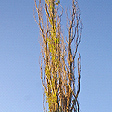 Populus nigra
Populus nigra
Poplar Canker (Cryptodiaporthe populea) infects the cambium layer damaging the bark and sapwood where the elongated sunken canker forms. Branches are girdled causing the upper portion to die off. This is a serious problem for Populus nigra var. Italica entering the plant through wounds or the leaves then spreading to twigs and branches. Control is difficult as removal of infected parts will not eradicate the problem, but encourage it. Young plants may be sprayed with a copper based fungicide to reduce leaf infection and heavily infected plants should be removed the burnt.
Stem Canker of Red Flowering Gum (Sporotrichum destructor) enters through wounds in the bark forming cankers in the trunk and branches, splitting the bark apart, revealing the wood and infesting the surface with powdery spores. This infection causes the leaves to wither and then the branches die, eventually killing the tree.
Stem Canker (Strumella coryneoidea) is a casual fungus that forms on the trunks of trees as a smooth, dispersed or sunken infection. On mature trees the infection sheds the bark with the canker forming callus tissue around the margins and the centre being exposed. These cankers then tend to extend up and down the trunk, only girdling over a long period of time. It is found on Quercus, Fagus, Aesculus species, and Acer rubrum , Nyssa sylvatica, Carya ovata and Morinda citrifolia.
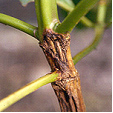
Source and Dispersal
The spores are found on infected dead plant material and can be dispersed by wind and with splashing water.
Favoured Conditions
It prefers a warm humid conditions and plants that have a wounds derived from poor pruning techniques and insect or other damage, especially if water is allowed to settle on the wound.
Affected Plants
Cankers may infect a wide range of trees and shrubs with some species being specific to its host. Examples are listed below.
Abies species are infected by several cankers including (Cytospora pinastri), (Cryptosporium macrospermum) and (Scoleconectria balsamea). These fungi form dead sunken areas on the trunk and branches.
Alnus species are infected by a few cankers including (Nectria coccinea) and (Physalospora obtusa) these attack the branches causing die back.
Betula species may be infected by the Canker (Nectria galligena) that occurs in the forks of trees causing splitting and cracking of the bark by swelling, to reveal the canker. Callus rings may form around the affected areas as a defence mechanism triggered by the tree.
Buxus species are infected by the Canker (Pseudonectria rousseliana) which shows signs of poor new growth during spring with the leaves turning from light green to a tan colour. These leaves tend to lay flat along the stems and reddish pustules appear both on the stems and leaves. The bark becomes loose and on inspection reveals a darkish colour underneath. It is difficult to control and the canker can kill the plant.
Castanea species are infected by the Twig Canker (Cryptodiaporthe castanea), a fungal problem that causes significant damage to the twigs and small branches, but tends to attack stressed trees.
Cercis and Ribes species are infected by the Canker (Botryosphaeria ribis) which forms small sunken areas on the stems causing wilting and eventually killing the branch by girdling. The cankers turn the bark black then split it open and the adjoining wood becomes discoloured. This is a serious problem for this and many other plant species.
Cotoneaster, Betula, Catalpa and Aesculus species are infected by the canker (Physalospora obtusa).
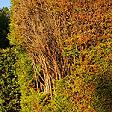
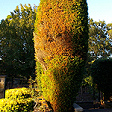 Cypress Canker
Cypress Canker
Cupressus species and Chamaecyparis lawsoniana are susceptible to Cypress Canker (Seiridium species) which causes leaf browning and then girdles the trunks resulting in ringbark. There is also another Canker (Coryneum cardinale) that has simular characteristics and is found in the northern hemisphere.
Cupressus sempervirens is infected by Cytospora Canker (Cytospora cenisia var. littoralis).
Larix species are susceptible to several fungal cankers including (Trichoscyphella wilkommii), (Trichoscyphella ellisiana), (Aleurodiscus amorphus), (Leucostoma Kunzei) and (Phomopsis spp.)
Nyssa sylvatica is attacked by three cankers including (Strumella coryneoidea).
Pinus species are infected by many types of cankers.
Platanus species are infected by Cankerstain.
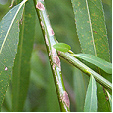 Cytospora Canker on Salix babylonica
Cytospora Canker on Salix babylonica
Pseudotsuga menziesii Douglas Fir is attacked by several cankers including (Cytospora species), (Dasyscypha ellisiana), (Dasyscypha pseudotsugae), (Phacidiopycnis pseudotsugae) and (Phomopsis lokoyae). These infections normally do not require control and are more prevalent on the coastal form.
Salix and Populus species are infected by several cankers including Cytospora Canker (Cytospora chrysosperma), Hypoxylon Canker (Hypoxylon pruinatum), Septoria Canker (Mycosphaerella populorum) and Branch Gall (Macrophoma tumefaciens). Many of these fungi can cause the death of the plant.
Thuja orientalis, Cupressus and Juniperus species are infected by the canker (Corynneum cardinale).
Tilia and Acer species are infected by (Nectria cinnabarina) attacking twigs or branches.
Tsuga species are infected by several cankers including (Dermatea balsamea) and ( Cytospora species).
Ulmus species are infected with up to eight fungal cankers including (Apioporthe apiospora) and (Nectria coccinea).
Vaccinium ovatum is infected by the canker (Coryneum microstictum) which attacks the stems.
Vinca species are infected by canker-dieback (Phomopsis livella) causing the shoots to wilt, turn brown and die. This can reduce the plant to ground level, and normally occurs during rainy periods.
Non-chemical Control
It is very difficult to control and correct pruning techniques with sharp tools for repairing wounds or prune well below the infected areas. Ensure that there are no ragged edges on the cuts and the angle should cut allows water to run off or dress the wound. Plant resistant varieties when available. Heavily infected trees should be removed to avoid spreading the disease.
Improve the culture of the affected plant to increase vigour for greater resistance.
Chemical Control
There is no satisfactory chemical control and prevention is imperative.
Note
Always read the label for registration details and direction of use prior to application of any chemicals.
DISEASE
NAME
Phytophthora Rot
Phytophthora species
Pathogen Name
A number of Phytophthora species cause these diseases but the most important species in Australia is the cinnamon fungus, Phytophthora cinnamomi. This species is exotic to Australia and probably originated from south east Asia; it has probably been present in Australia for close to 200 years. Phytophthora are fungal-like organisms that are related to some protozoa and algae; they are microscopic and cannot be observed by the naked eye.
Description
There are many types of Phytophthora Rot but generally the disease affects the plant by causing a soft rot of the affected plant part. The most common form of the disease is a rotting of the roots that occurs below ground with no visible symptoms of the disease above ground until the disease starts to cause leaf drop.
Symptoms
The disease is initiated below ground in the soil, usually on the feeder roots of a plant. The pathogen grows through the roots killing cells and eventually causing an extensive root decay. This causes the infected plant to lose vigour and the leaves to yellow and die. Entire branches starting from the top then die, quickly during hot weather or linger for months. The infection occurs on the root hairs causing small and large roots to rot. The symptoms of the disease are often very difficult to differentiate from drought symptoms, mainly because the affected root system prevents the uptake of moisture from the soil. Once the disease has progressed far enough large branches will die causing the typical dieback symptoms.
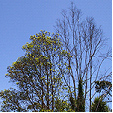
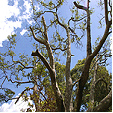
There are a number of other diseases caused by Phytophthora species
Twig Die Back (Phytophthora ilicis) attacks Ilex species causing black leaf spots and black stem cankers.
Phytophthora cactorum is known by several common names depending on which plant is being attacked and they have various symptoms. Plant species are listed below.
Root Rot (Phytophthora richardiae) infects Zantedeschia species causing the leaves to turn yellow, wilt and die. Flowers are deformed if they bloom and the infection can also be seen in the new growth, eventually killing the plant. On inspection the roots show signs of decay.
Stem Rot (Phytophthora cryptogea) infects the roots and stems turning them brown and seeds are also attacked causing decay. It is commonly found on Tagetes erecta and infected plants wilt, collapse and die.
Source and Dispersal
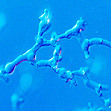 Sporangia
Sporangia 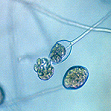 Zoospores
Zoospores 
Image by Dr Brett Summerell
Phytophthora species produce sporangia that contain specialised zoospores that have flagella that allow them to move through the soil moisture small distances. These spores encyst on the root and then penetrate the root. The pathogen also produces chlamydospores, specialised survival spores that allow it to survive in the soil for extended periods of time. The chlamydospores can be transported in soil, even extremely small amounts, allowing the pathogen to be dispersed very easily throughout an area and from one location to another. The zoospores are easily moved in water flowing through soil and so are easily dispersed down slopes. It is not uncommon for the disease to move in fronts down a slope.

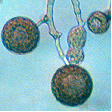 Chlamydospores, specialised survival spores
Chlamydospores, specialised survival spores
Image by Dr Brett Summerell
Favoured Conditions
Phytophthora root rot is favoured by poorly drained soils or in soils that are waterlogged for short periods of time. The disease generally occurs during periods when the temperature is above 16ºC although it has been observed in snow gum country in the Barrington Tops National Park and in southern Tasmania. It also prefers soils that have little organic material.
Affected Plants
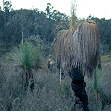
 Xanthorrhoea species
Xanthorrhoea species
Image by Dr Brett Summerell
The host range that is attacked by Phytophthora cinnamomi is enormous and is still not well understood but includes many Australian native plants, Rhododendrons, Acer and Prunus species, conifers, cabbage tree and strawberries. Some Australian plant families that are quite susceptible include species in the Proteaceae, Epacridaceae and Xanthorrhoea species.
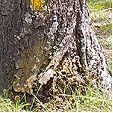 Alphitonia excelsa
Alphitonia excelsa
Alphitonia excelsa can be infected by Phytophthora cinnamomi causing loss of foliage, death of the upper branches and cankers on the trunk.
Cactus such as Cereus species may be infected with Slimy Collar Rot (Phytophthora cactorum) which forms a soft black area at the base of the plant that is water soaked.
Chamaecyparis species may be infected with the Root Rot (Phytophthora lateralis) that attacks roots, trunk, stems and leaves.
Cornus species are infected by Crown Canker (Phytophthora cactorum) and in this case the tree is partially infected initially with one side producing smaller leaves that turn reddish in late summer. The leaves may also shrivel and die prematurely, during dry periods and small and large branches die. After a couple of seasons the tree becomes completely infected with poor top growth and an inconspicuous canker develops at the base of the trunk. Eventually the tree dies.
Erica species are infected by (Phytophthora cinnamomi). The symptoms include foliage turning greyish towards the top, and then the plant wilts then dies with evidence of infection at the base.
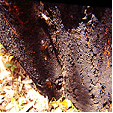 Phytophthora in Eucalyptus species
Phytophthora in Eucalyptus species
Image by B. Sonsie

Image by Dr Brett Summerell
Eucalyptus species are infected by Phytophthora cinnamomi causing rapid die back of the tree with blackened trunk loss or upper growth and is a serious problem for certain species such as Eucalyptus diversicolor (Karri).
Euphorbia pulcherrima is susceptible to Root Rot (Phytophthora and Pythium species). Roots become dark and the rot can extend up the stem. The plant is also susceptible to leaf blight resulting from the same fungal disease.
Hedera species are infected by Phytophthora Blight (Phytophthora palmivora). This fungus causes leaf spots, foliage blight and stem rot.
Palms such as Archontophoenix, Caryota, Chamaedorea, Cocos, Dypsis, Howea, Liculia, Linospadix, Livistona, Phoenix, Ptychosperma, Rhapis, Roystonea, Syagrus, Washingtonia and Wodyetia species are also susceptible to Phytophthora Blight forming large irregular areas on the fronds that become dark and rotten and limited by the veins
Lilium species are infected by Foot Rot (Phytophthora cactorum) which attacking the stems just below the soil level causing the plant to topple and if infection occurs as the leaves are emerging the base of the infected leaves which collapse remain attached to the bulb.
Morinda citrifolia is infected by Phytophthora Blight, black flag disease (Phytophthora species) which causes the foliage to turn black and limp. The fruit and stems are also infected causing them to turn brown-black and whither.
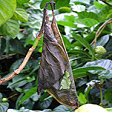
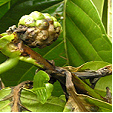 Morinda citrifolia
Morinda citrifolia
Orchids such as Cattleya, Cymbidium, Cypripedium, Dendrobium, Epidendrum, Paphiopedilum, Phalaenopsis and Zygopetalum species are infected by Black Rot (Phytophthora or Pythium species). This causes the leaves, pseudobulbs, rhizomes and roots to form a dark soft rot, normally occurring towards the base of the plant.
Saintpaulia, Dianthus, Gypsophila, Limonium and Anemone species are infected by Root and Crown Rot (Phytophthora nicotianae). This is a fast moving fungus that turns the roots blackish then extends to the crown and petioles causing wet rot of the crown then wilting, eventually killing the plant. When found as Phytophthora Leaf Spot or Blight, angular spots appear with water-soaked margins as in Cordyline and Philodendron species.
Sedum species can be infected by up to three Stem Rot fungi including (Colletotrichum species), (Phytophthora species) and (Pellicularia filamentosa). Commonly occurring in wet soils.
Ulmus and Acer species are also infected by (Phytophthora cactorum) and this is known as Bleeding Canker. This casual disease initially causes cankers in the bark that ooze sap and the sapwood forms reddish lesions with greenish margins. The leaves on affected branches turn yellow, wilt then die and mildly affected trees may survive.
Many species are infected by the Bleeding Canker including Acer platanoides, Acer rubrum, Acer pseudoplatanus, Acer saccharinum, Betula species, Liquidambar styraciflua, Aesculus x carnea, Tilia, Salix and Quercus species.
Non-chemical Control
The most effective control for all Phytophthora diseases is prevention primarily because it is extremely difficult to control Phytophthora diseases after they are established in the plant. As Phytophthora species are most easily transported in infested soil quarantine is an essential component of control of the disease and it is for this reason many areas have hygiene protocols to stop the pathogen being introduced into an area. It is recommended that bush walkers take care not to introduce the pathogen on their boots into un-infested areas and for this reason it is suggested that walking boots be cleaned and preferably sterilised (with 70% methylated spirits) prior to starting a walk.
Cultural techniques such as cultivating the soil regularly with added animal manure and other organic substrates to ensure there is good drainage will also help to minimise the impact of the disease. The plants can be mulched with straw or other organic material taking care that the base of the trunk is left clear. Avoid over watering the soil and observe hygiene in regards to tools, containers or shoes to reduce spreading the infection.
Potting mixes should be pasteurised for 30min at 60ºC to ensure that they are free of the pathogen. It is also very important to grow pots off the ground to prevent the splash of infested mix or water from an infected plant to clean plants.
.
Avoid damaging the bark particularly at ground level and seal any wounds that occur. If cactus or tree species are infected it is possible to cut out the infected area when first seen in order to contain it. Correct tree surgery techniques are required for large trees.
Chemical Control
There are a number of fungicides that are registered for use in the control of these diseases. The most effective chemical control are based on the use of chemicals containing potassium phosphonate. This chemical effectively enhances the defence systems of the plant and has been shown to be most effective in controlling Phytophthora diseases. It is essential that the chemical be applied when the plants is exporting nutrients to the roots, so this is best in the warmer months. The chemical can be applied as a stem injection or a foliar spray, and in some situations as a soil drench. There are specialised stem injecting equipment available for stem injections on larger trees.
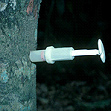
Image by Dr Brett Summerell
Note
Always read the label for registration details and direction of use prior to application of any chemicals.
Amendments by
Dr Brett Summerell
Director Science and Public Programs
Royal Botanic Gardens Trust, Sydney
DISEASE
NAME
Leaf Spot (General)
Various Leaf Spot Species
Description
There is a wide variety of fungal leaf spots that infect perennials, shrub and trees. Some are specific to the host while others can affect a range of plants.
Symptoms
Generally light brown to purplish or blackish spots appear on the leaf and form concentric rings of fruiting bodies. The spots may leave holes, perforating the leaf or expand with pale green to yellowish margins and when the holes merge the leaf normally dies. There are many different types of leaf spot, some are discussed below.
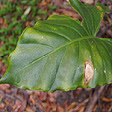 Alocasia species
Alocasia species 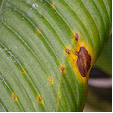
Alternaria Leaf Spot (Alternaria nelumbii) forms a small reddish brown spots that are boarded in light green, and as they develop in size the leaf curls and dies from the margin inwards. Normally occurs on Nelumbo species (water lilies).
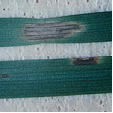 Helminthosporium Disease
Helminthosporium Disease
Helminthosporium Disease (Bipolris species), (Drechslera species) and (Exserophilum species) are responsible for several leaf spots that occur on all Turf Grass species. Generally they form black or white spots that may be faded and produce masses of spores in the thatch during late summer, under humid conditions. The life cycle is short and when conditions are favourable spores are splashed onto the foliage from the thatch, causing wide spread infection. Cynodon dactylon (common couch) is most susceptible and found in bowling or golf greens where it is a serious problem.
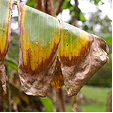 Banana Leaf Spot
Banana Leaf Spot 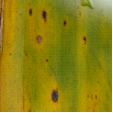
Banana Leaf Spot (Mycosphaerella musicola) is found on many species of banana causing pale yellow streaks on the young leaves to turn brown with dark spots. The leaf then becomes dried, brown and dead commencing from the margins, eventually the leaf dies. Control requires removal of infected foliage or the spraying of a fungicide and fungicides should not be used during the fruiting period.
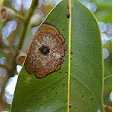
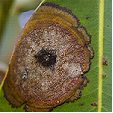 Lophostemon confertus (Brush Box)
Lophostemon confertus (Brush Box)
Leaf Spot on Brush Box (Elsinoe species). This is a casual fungus that attacks the epidermal layer of the leaf, forming circular spots that are up to 25mm across and are often restricted by the main vein. These spots are a dull yellowish brown but can also have purplish patterns. A leaf may have more than one spot develop on its surface and normally appears on scattered leaves throughout the tree. This doesn't affect the vigour of Lophostemon confertus.
Palm Leaf-scab (Graphiola phoeicis) appears as yellow spots and develop into scabs or warts that are outwards hard and dark but with a soft centre with powdery yellowish brown spores. The infected leaves eventually die.
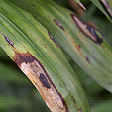 Palm Leaf Spot, Chamaedorea elegans
Palm Leaf Spot, Chamaedorea elegans
Palm Leaf Spot (Pestaloptiopsis species) appears as a small spot with a dark centre on the leaves and affects palms that are growing in shaded humid positions and normally control is not required, though infected fronds should be removed.
Source and Dispersal
Infection source is other contaminated plants and the spores are spread by wind or by splashing water. The fruiting bodies are black spots that appear on the damaged tissue releasing spores.
Favoured Conditions
This fungus prefers a warm humid environment and leafy plants with soft new growth, particularly if they are crowded.
Affected Plants
There are many ornamental and native plants that are hosts to a wide range of fungal leaf spots. Some specific ones are listed below. Plants such as Cornus or Paeonia species are infected by a large variety of leaf spots, while other plants attract a specific leaf spot.
Generally a healthy plant can tolerate fungal leaf spot attack, though it may make the plant look unsightly. In trees and shrubs it is difficult to control and generally not necessary, but in perennials and annuals control may be necessary in order to save the plant.
Acalypha and Arctotis species are infected by up to three leaf spots including (Cercospora acalyphae) and (Ramularia acalyphae) that rarely require control.
Acer species are infected by Purple Eye (Phyllosticta minima) which forms spots with brownish centres and purplish margins causing the death of the leaves.
Acer species are also infected by Tar Spot (Rhytisma acerinum) which forms round black spots that have yellow margins. Not normally seen on cultivated trees, but seen in forests.
Adiantum, Asplenium, Blechnum, Cyathea, Davallia, Nephrolepis, Platycerium, Polypodium and Pteris species are infected by the leaf spot (Pseudocercopora species) which forms circular brown spots on the fronds and heavy infection can defoliate a plant.
Aesculus species are occasionally infected with the leaf spot (Septoria hippocastani) which forms small brown spots.
Agave species are susceptible to the leaf spot (Coniothyrium concentricum), which appear as greyish spots up to 20mm (1in) across with concentric rings and black fruiting bodies. Affected leaves are destroyed as the infection spreads.
Albizia julibrissin is susceptible to the fungal leaf spot (gloeosporium aletridis), which does not normally require control.
Amelanchler, Chaenomeles, Crataegus and Rhaphiolepis species Mespilus germanica are infected by the leaf spot (Fabraea maculata) which may cause considerable damage during wet periods.
Aquilegia species can be infected by three types of Leaf Spot including (Ascochyta aquilegiae), (Cercospora aquilegiae) and (Septoria aquilegiae), normally appearing during humid conditions forming spots on the leaves.
Arbutus species are infected by two leaf spots (Septoria Unedonis) which produces small brown spots on the leaves and (Elsinoe mattirolianum).
Arctostaphylos manzanita is infected by the leave spot (Cryptostictis arbuti) which damages leaves but is not normally detrimental to the shrub.
Aspidistra species are infected by the leaf spot (Colletotrichum omnivorum) causing whitish spots on the leaves and petiole.
Aster species are infected by many leaf spots including (Alternaria species), (Cercosporella cana), ( Ovularia asteris) and (Septoria asteris).
Aucuba species are infected by several leaf spots, usually as a secondary infection after aphid attack. These include (Phyllosticta aucubae) and (Phyllostica aucubae).
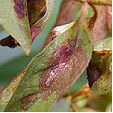
 Azalea
Azalea
Azalea (Rhododendron species) are susceptible to Leaf Scorch (Septoria azalea). This fungal disease forms reddish- brown spots which expand and engulf the leaf, with fruiting bodies appearing in the centre. Infected leaves die, then fall and the branchlets wilt. This problem is more serious during wet periods and may require control using a fungicide.
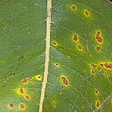 Banksia robur
Banksia robur
Banksia species are infected by several leaf spots causing chlorotic areas that have brown centres and is not normally a major problem for the plant.
Betula species may be infected by the Leaf Spots (Gloeosporium betularum) that forms brown spots with darker margins and (Cylindrosporium betulae) that also forms brown spots with faded indefinite margins.
Bougainvillea species are infected by the leaf spot (Cercosporidium bougainvilleae) which forms rounded spots with dark margins that yellowish ting. Infected leaves die and fall from the plant.
Calendula species are infected by the Leaf Spot (Cercospora calendulae) which rapidly infects the plant spotting the leaves and killing the plant.
Callicarpa species may be infected by the leaf spot (Atractilina callicarpae) forming irregular brownish spot or (Cercospora callicarpae) which can defoliate the plant in subtropical climates.
Campsis species may be infected by several fungal leaf spots including (Phyllosticta tecomae), (Septoria tecomae) and (Cercospora duplicata).
Carpinus species are infected by the leaf spots (Gloeosporium robergei), (Gnomoniella fimbriata) and (Septoria carpinea), all are minor infections not normally requiring control.
Carya species are infected by several leaf spots including (Gnomonia caryae) that infects leaves with irregular reddish spots on the upper surface with corresponding brown spore producing spots on the underside. It also has a secondary spore release that occurs on the dead leaves where it over winters. Other leaf spots include (monochaetia desmazierii) and (Marssonina juglandis).
Ceanothus species are susceptible to the leaf spot (Cercospora ceanothi) and (Phyllosticta ceanothi) both are of minor importance not requiring control.
Celtis species are infected by many leaf spots including (Cercosporella celtidis), (Cylindrosporium celtidis), (Phleospora celtidis) and (Septogloeum celtidis).
Chrysanthemums species are infected by the leaf spot (Septoria species) which forms yellow spots appear toward the edge of the leaves; these become enlarged brownish patches with yellow margins. Damaged areas may converge and in severe attacks and the leaves may fall prematurely or flower production is reduced.
Clematis species are infected by the fungal disease (Ascochyta clematidina) which may cause stem rot or leaf spots that are water soaked areas with reddish margins. The infection spreads from the leaves to the stem causing wilting and eventually girdling the stem killing the plant. There are many fungal leaf spots that infect this plant including (Cercospora rubigo) and (Septoria clematidis)
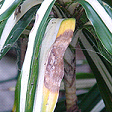 Dracaena deremensis
Dracaena deremensis
Cordyline and Dracaena species may be infected by the leaf spot (Phyllosticta maculicola) which forms small brownish spots that have yellowish margins and has black fruiting bodies that forms coils of spores. These plants are also susceptible to other leaf spots such as (Glomerella cincta) and (Phyllosticta dracaaaenae). Keep foliage dry to avoid infection.
Cynodon dactylon, Pennisetum clandestinum and many other Turf Grasses are susceptible to Helminthosporium Disease.
Daphne species are infected by the leaf spot (Gloeosporium mezerei) and (Marssonina daphnes) both of which form thickish brown spots that are seen on both sides of the leaves. Infected leaves turn yellowish before dieing.
Dendranthema species are infected by many leaf spots such as (Septoria chrysanthemi) which first forms yellowish spots up to 25mm (1in) across that become black. Infected leaves die prematurely and persist on the plant.
Dianthus species may be infected by the leaf spot (Septoria dianthi). It forms light brown rounded spots that have a purplish border. The scattered spots on the lower leaves can also be found on the stems and the spores are dispersed by water from the tiny black fruiting bodies.
Dieffenbachia species are infected by several leaf spot fungi including (Cephalosporium species) and (Myrothecium species).
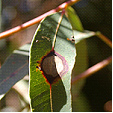 Eucalyptus species
Eucalyptus species
Eucalyptus species are infected by many fungal leaf spots such as (Mycosphaeralla species), (Hendersonia species) and (Monocheatia monochaeta). Generally leaf spots appear on the juvenile or new leaves causing brownish spots that enlarge and may have a purplish halo around the margin. Mature adult leaves are not normally infected and the trees rarely require control measures.
Fern species are infected by the leaf spot, (Alternaria polypodii). This fungus appears as brown circular or oblong spots that congregate along the margins of the pinnae causing the fronds to turn brown and die. It is spread by wind currents from plant to plant and control methods include removing infected fronds and maintaining a drier atmosphere.
Ficus species are infected by various fungal leaf spot including (Pseudocercospora species). Generally the fungal attack forms circular or irregular dark coloured spots on the leaves eventually causing them to fall prematurely.
Ficus elastica is susceptible to many fungal leaf spots including (Alternaria species), (Leptostromella elastica) and (Phyllosticta roberti).
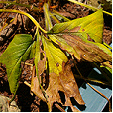
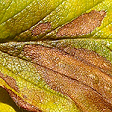 Strawberry
Strawberry
Fragaria x ananassa (Strawberry) is infected by the fungal leaf spot (Mycospharella fragariae). The mature leaf is initially infected with well defined brown spots that that turn light grey with red-purplish margins. As the spots merge they form large brown blotches and the leaf turns yellow then dies. This fungal attack normally occurs on plants in poor health and can be a serious problem early in the season seriously damaging stock.
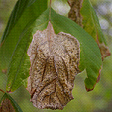 Fraxinus species
Fraxinus species
Fraxinus species are infected by the leaf spot (Gloeosporium aridum) giving the leaf a scorched appearance as large blotches appear from the margin or apex and turn brown with a papery texture. It is more prevalent during rainy periods and infected leaves fall prematurely. Collect and depose of fallen leaves otherwise control is not normally required.
Fuchsia species may be infected by the leaf spot (Septoria species) or ( Cercospora species), both form spots with dead centres and dark margins.
Gladiolus species are infected by Hard Rot or Leaf Spot (Septoria gladioli). On the corms reddish brown circular water soaked spots become large and sunken. These areas dry out and form obvious margins. The leaves may also have these symptoms but is not commonly seen.
Hemerocallis species are infected by several leaf spots including (Cercospora hemerocallis) and (Heterosporium iridis). These may be in the form of black spots or brownish spots that converge killing the leaf. Infected leaves should be removed and burnt.
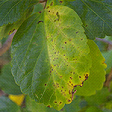 Hibiscus species
Hibiscus species
Hibiscus rosa-sinensis, Hibiscus syriacus and Hibiscus tiliaceus are susceptible to several fungal leaf spots including (Ascochyta abelmoschi), (Cerospora kellermanii) and (Phyllosticta hibiscina). All cause spotting or blotching of the leaf surface; remove and destroy infected parts.
Hydrangea species are infected by four fungal species including (Ascochyta hydrangeae), (Phyllosticta hydrangeae) and (Septoria hydrangeae).
Iris species are infected by several fungal leaf spots including (Alternaria iridicola) and (Macosphaerella species).
Iris species are also infected by the leaf spot (Didymellina macrospore) that forms greyish spots with brown water soaked borders and coalesce on the upper part of the leaf. This casual organism commonly occurs after flowering killing the leaves but will not infect the bulbs. The bulbs become weak over several seasons due to the decreased foliage.
There is also a Bacterial Leaf Spot (Bacterium tardicrescens) that is commonly mistaken as a fungal problem causing translucent spots that coalesce and involve the entire leaf. Normally found on Iris species.
Laburnum anagyroides is infected by the Leaf Spot (Phyllosticta cytisii). The leaf forms light grey spots with no definite margin and mature to brown. The black fruiting bodies appear as dots in the centre of the spot.
Leucanthemum species are infected by the leaf spot (Cerocspora chrysanthemi) and (Septoria leucanthemi).
Magnolia species are susceptible to many species including (Alternaria tenuis), (Mycosphaerella milleri) and (Phyllosticta species). Leaves generally turn brown from the apex or margins turning brown or spots appear on the leaf surface and leaves become yellow before withering and dieing. Normally the make the tree look poorly but have little effect on its growth. Control is not normally required.
Nerium oleander is susceptible to several fungal leaf spots including (Cercospora nerella), (Cercospora repens), (Gloesporium species) and (Phyllosticta nerii). Infected leaves should be removed but generally control is not required.
Nyssa sylvatica is infected by the leaf spot (Mycosphaerella nyssaecola) forming irregular purplish blotches.
Orchids such as Cattleya, Cymbidium, Cypripedium, Dendrobium, Epidendrum, Paphiopedilum, Phalaenopsis and Zygopetalum species are infected by several leaf spots including (Cerospora, Colletotrichum and Phyllosticta species). Normally forming dark or dead, circular or irregular areas on the leaves.
Palms such as Syagrus, Howea, Phoenix, Roystonea and Washingtonia species are infected by Leaf-scab (Graphiola phoeicis).
Palms such as Archontophoenix, Caryota, Chamaedorea, Cocos, Dypsis, Howea, Liculia, Linospadix, Livistona, Phoenix, Ptychosperma, Rhapis, Roystonea, Syagrus, Washingtonia and Wodyetia species are susceptible to several fungal leaf spots including;
(Bipolaris spp.), (Cylindrocladium spp.), (Colletotrichum spp.) and (Pestalotiopsis spp.).
Generally the circular leaf spots are brown and may have a yellow halo such as Palm Ring Spot (Bipolaris incurvata). They vary in size from small to large depending on the species. When a plant is healthy it recovers from attack, but heavy infections can defoliate, causing the collapse of the plant.
Palms are also infected by the Brachybasidium Leaf Spot (Brachybasidium pinangae). This fungus forms angular leaf lesions that produce fruiting bodies on the underside and is commonly found on Archontophoenix species.
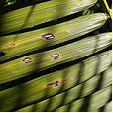
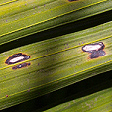 Archontophoenix cunninghamiana
Archontophoenix cunninghamiana
Passiflora species are infected with many types of leaf spot such as (Alternaria passiflorae).
Phoenix species are susceptible to False Smut (Graphiola phoenicis). This fungus forms yellow leaf spots that become hard with a raised with a blackish scab, which produces masses of powdery spores that are thread-like.
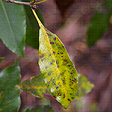
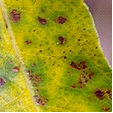 Pittosporum species
Pittosporum species
Pittosporum species are susceptible to the leaf spots (Alternaria tenuissima), (Phyllostica species) and (Cercospora pittospori). Circular or angular dark spots appear on the leaves and are surrounded by necrotic areas that are yellowish. Generally removal of infected leaves is adequate control.
Poa species and other cool season grasses are infected by Winter Fusarium Leaf Disease (Fusarium species), which causes small pale spots that are water soaked to appear on the leaves that turn red-brown. Infected leaves become bleached then wither and die, but the infection will not affect the crown or roots of the plant. It can be identified by pink, cotton-like mycelium and the plant prefers cold wet weather.
Populus species are infected by several fungal leaf spots including (Ciborinia bifrons, Ciborinia confundens), and (Mycosphaerella populicola).
Prunus species are infected by several leaf spots including (Cercospora circumscissa and Septoria ravenelii).
Pseudotsuga menziesii Douglas Fir is infected by the Leaf Cast (Rhabdocline pseudotsugae) Symptoms include the needles becoming yellowish at the apex and extending down the needle and spreading to others during moist spring weather turning them brown. Brownish scorched areas are noticeable on the tree from a distance. Control; is not normally required for mature trees but nursery stock may require spraying with a copper based fungicide.
Psidium guajava (Guava) is infected by (Glomerella cingulate). This fungus courses spots to appear on leaves and mummifies and blackens immature fruit or rots mature fruit. This fungus can devastate a guava crop.
Quercus species are infected by several types of leaf spot including (Cylindrosporium microspilum) and (Marssonina martini). These attacks tend top take place later in the season and normally not detrimental to the tree.
Rhododendron species are infected by a large variety of fungal leaf spots including (Cercospora rhododendri) and (lophodermium melaleucum)
Salix species are infected by several fungal leaf spots including (Ascochyta salicis) and (Septogloeum salicinum).
Senecio species are infected by the fungal leaf spot (Alternaria cinerariae) and (Cercospora species), forming dark rounded or angular spots.
Spiraea species are attacked by the fungal leaf spot (Cylindrosporium filipendulae).
Stenotaphrum secundatum (Buffalo) turf grass is susceptible to Grey Leaf Spot (Pyricularia grisea) in domestic and commercial situations devastating lawns. This fungal disease infects the stems and leaves with small brown lesions that enlarge rapidly forming grey-brown spots that have darker borders or surrounded by yellow chlorotic areas. This infection is commonly found on newly laid turf but will also infect established lawns. It is most prevalent during warm humid periods in soil with a high nitrogen level.
Syringa species are attacked by up to six species of leaf spot including (Cercospora lilacis) and (Phyllostica species).
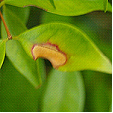 Syzygium species
Syzygium species
Syzygium species are infected by fungal leaf spots but normally control is not required.
Tagetes species are infected by the leaf spot (Septoria tageticola), which starts at the base and moves progressively up through the plant, covering the leaves in grey to black spots.
Trillium species are host to several leaf spots, including (Colletotrichum peckii) (Gloeosporium Trillii) (Heterosporium trillii).
Ulmus species are infected by many fungal leaf spots including (Gnomonia ulmea) and (Cercospora sphaeriaeformis).
Veronica species are infected by the leaf spot (Septoria veronicae). The symptoms include small violet to brown spots appear on the upper surface of the leaf and correspondingly yellowish brown on the underside. The spots converge forming a scorched shot-hole appearance and eventually death of the leaf.
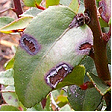 Vaccinium ovatum
Vaccinium ovatum
Vaccinium ovatum is infected by the leaf spot (Rhytisma vaccinii) and (Dothichiza caroliniana).
Vicia species are infected by the leaf spot (Erostrotheca multiformis), which forms greyish spots that enlarge and may defoliate the plant.
Wisteria species are infected by three fungal leaf spots (Phyllostica wisteriae), (Septoria wisteriae) and (Phomatospora wisteriae).
Non-chemical Control
Remove and destroy infected plant material and avoid overhead watering. When planting select infection resistant varieties. Practice crop rotation and add pot ash to the soil to decrease the plants venerability to the disease. Many species of fungus overwinter in fallen leaves, remove and destroy any litter under the plant.
Winter Fusarium Leaf Disease in Turf Grasses can be minimised by aerating the soil, reducing thatch and avoid excessive nitrogen in the soil.
Chemical Control
Protective fungicides such as zineb or copper oxychloride should be sprayed at the first sign of infection and cuttings should be sprayed as they start to grow.
Note
Always read the label for registration details and direction of use prior to application of any chemicals.
DISEASE
NAME
Powdery Mildew
Various Powdery Mildew Species
Description
Powdery mildew covers arrange of fungal infections most with simular characteristics of white powdery areas appearing on the leaves and flowers.
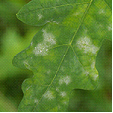
 White powdery area
White powdery area 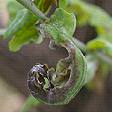
Symptoms
Powdery mildew (Oidium species) affects the following five plant groups with slightly different characteristics.
Cucurbits firstly form white spots on the underside of the leaves. Under optimum conditions the fungus spreads to the upper surface covering the entire leaf causing it to die. It may also extend to the stems slowing the growth of the plant and may reduce the size of the fruit.
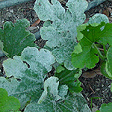
Grape leaves, flowers and fruit are attacked with the appearance of greyish-white powdery spots. Infected flowers set poor quality fruit and infected fruit splits open and dries out.
Pawpaw leaves become infected on the underside at first then spreading covering the entire leaf. The fruit forms irregular light grey spotted areas that damages the surface and under the surface causing the fruit to misshapen and reducing its market value.
Rose leaf and buds are covered in a fine white powdery coating and in severe cases it extends to the stems. When young leaves are infected they become distorted and older leaves develop blackened areas. Infected flower buds may fail to open and opened blooms may be discoloured or distorted.
Strawberries show different signs of infection with the leaf margins first rolling upwards then developing purplish irregular blotches along the veins. The infected flowers may fail to set fruit and if fruit is produced it is small, hard fails to ripen. Semi mature fruit that is infected has dull appearance and may form cracks or split open.
The Powdery Mildew (Sphaerotheca lanestris) infects leaves and twigs. The under side if the leaf firstly has a white mealy growth that matures to felt-like brown mycelium that can cover the entire leaf, and the twig tips. It is only one of the many types that infect Quercus species.
Source and Dispersal
The spores overwinter in fallen leaves, dormant buds, seed and infested plants. It is dispersed by wind.
Favoured Conditions
Generally it prefers warm humid conditions, but failing to germinate when it is raining. The fungus that attacks Pawpaw prefers cooler conditions disappearing in the warmer months.
Affected Plants
There are many plant species ornamental trees and shrubs that are attacked by Oidium species including; Roses, African Violets, Cucurbits, Grapes, Pawpaw, Strawberries, Hydrangeas, Ajugas, Antirrhinum, Oaks and Photinias.
Acer species are infected by the powdery mildews (Uncinula circinata) and (Phyllactinia corylea) but are not normally serious.
Aesculus species are infected by the powdery mildew (Uncinula flexuosa) which forms a white mold on the underside of the leaves.
Arenaria,Cuphea, Erica and Eschscholtzia species are infected by the powdery mildew (Erysiphe polygoni). This fungus is greyish or white and covers leaves or young shoots. Heavenly infected leaves turn brown and fall from the plant. The plant eventually dies.
Aster species are infected with the powdery mildew (Erysiphe cichoracearum) which is more prevalent on the lower part of the plant.
Ceanothus, Corylus, Platanus, Syringa and Weigela species are infected by the powdery mildew (Microsphaera alni) particularly London Plane. The mycelium forms a felt-like cover on the leaves.
Celtis species are susceptible to the powdery mildew (Uncinula parvula) and (Uncinula polychaete). This fungal problem can affect either side of the leaf, which can have spots or be completely coved in mildew. The fruiting bodies appear on the opposite side of the mildew.
Cornus species leaves are infected by the powdery mildew (Microsphaera alni) and (Phyllactinia corylea), covering the leaves in a whitish fungus.
Dahlia species are infected by the powdery mildew (Erysiphe cichoracearum) that forms white powdery areas on the leaf surface.
Lagerstroemia species are infected by the powdery mildew (Uncinula Australiana) that forms white powdery growth on the leaves and may also distort the infected foliage.
Populus and Salix species are infected by a white powdery mildew (Uncinula salicis) that produces black fruiting bodies with a curled tip, but is not normally a major problem.
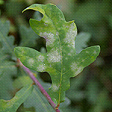
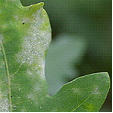 Quercus robur
Quercus robur
Quercus species are susceptible to several powdery mildew fungi including (Sphaerotheca lanestris), (Erysiph trina) and (Phyllactinia corylea). Generally white mealy growth appears on the leaves, normally on the underside turning the infected areas brown and then the leaf dies. The infection may spread to the twig tips causing dieback. Control may be difficult and unwarranted on large trees but nursery stock may be sprayed with a fungicide during susceptible periods.
Rosa species are also infected by the powdery mildew (Sphaerotheca pannosa).
Rudbeckia and Senecio species are covered in white fungus (Erysiphe cichoracearum) which infects leaves, flowers and stems. This results in the plant becoming stunted.
Senecio species are infected by the powdery mildew (Sphaerotheca fuliginea) which forms circular white powdery areas on the leaves.
Spiraea species are infected by the Powdery Mildew (Microsphaera alni) and (Podosphaera oxyacanthae).
Ulmus and Rhododendron (Azalea) species are also infected by (Microsphaera alni). Circular patches of white powdery growth appear on the leaves.
Veronica species are sometimes infected by the powdery mildew (Sphaerotheca humili) causing a white coating to appear on the leaves. Not normally a major problem.
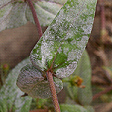
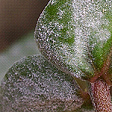
Zinnia elegans are commonly infected by the powdery mildew (Erysiphe cichororacearum), which appears on both sides of the leaves as a greyish powdery cover and may be transmitted by seed.
Non-chemical Control
Choose less susceptible species and when planting space the plants to allow good air circulation. Avoid overwatering and try to keep the foliage dry. Affected plants may be dusted with powdered sulphur or sprayed with a milk mixture to discourage mildew. Vegetables that are infected with mildew should be removed and replaced with new young plants, as they are more resistant to infection.
Chemical Control
Prenatitive spraying during warm humid conditions using a suitable fungicide such as wettable sulphur, bitertanol, carbendazim, fenarimol and triforine helps control the problem.
Note
Always read the label for registration details and direction of use prior to application of any chemicals.
DISEASE
NAME
Verticillium Wilt
Verticillium dahliae
Description
This is a soil based fungus that attacks the root hairs and travels throughout the plants vascular system.
Symptoms
With annuals or perennials such as dahlias lower leaves wilt, turn brown and die and the stems appear normal until the base splits open and turns blackish. This may extend throughout, killing the plant. With larger trees the fungus causes the leaves at the end of the branches wilt and die off.
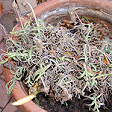
Verticillium albo-atrum is a soil born fungus that normally infects the roots acting on the water conducting cells by restricting flow causing the plant to wilt. On trees the leaves suddenly wilt and die. This may happen on individual branches on one side of the tree. Other symptoms are leaves form smaller than usual turning yellow and the plant may not shoot the following season. Trees may die over a short or long period of time depending on the severity or number of infections it has incurred and Acer saccharinum and Catalpa species are most susceptible.
Source and Dispersal
It is found in the soil and dispersed by movement of soil i.e. in containers or on machinery. The fungus may survive in the soil for many years.
Favoured Conditions
Moist poorly drained soils are prone to fungus and during the cooler humid months the fungus is most active.
Affected Plants
There is a wide range of hosts including tomatoes, potatoes, chrysanthemums and other perennials. It also found in shrubs and trees.
Acer, Achillea, Koelreuteria , Paeonia and Syringa species are infected by Verticillium albo-atrum causing wilting. Erythrina x sykesii may also become infected.
Berberis species are infected with Verticillium albo-atrum causing the leaves to turn brown, shrivel then die.
Non-chemical Control
Cultivate soil to improve drainage and aeration. Cut down and destroy any infected plant material and when taking cuttings from a susceptible plants quarantine them, to ensure they are not infected. Infected soil may be allowed to lay fallow for 2 to 3 years and when replanting used resistant plant varieties.
Chemical Control
For quick control of a cultivated area the soil will require treatment with a fungicide. Consultation with your local Department of Agriculture is advised.
Note
Always read the label for registration details and direction of use prior to application of any chemicals.
DISEASE
NAME
Virus (Generally)
Various Virus Species
Viruses can infect any plant and there are hundreds of types, but unlike fungi and bacteria viruses can only reproduce inside a living cell. Viruses are small requiring a magnification of x 10,000 to be seen and infection can be transmitted from one plant to another causing a variety of symptoms. Infected cells normal function, in the plant is diverted to aid the virus to reproduce by supplying nutrients and energy. The virus can spread from cell to cell or travel through the vascular system in the plant and may only infect a specific part of the plant, normally the new growth or the whole plant.
Lethal Yellowing
This fatal disease is not a virus, but of uncertain origin that is associated with mycroplasmas or mycroplasma-like-organism and infects palms, particularly Cocos nucifera (Coconut Palm).
The symptoms include premature dropping of the fruit at all stages (shelling) and these have brown-black water soaked areas under the calyx. The second symptom is the blacking of the new inflorescence as it is exposed from the spathe. Male flowers are also blackish and fruit will not set.
The third stage of this infection causes the lower fronds to turn yellow, eventually engulfing the entire crown. The fronds turn brown and easily fall from the plant and the infection kills the entire plant within 3 to 6 months with the crown falling away leaving a bare trunk.
Some palm species only exhibit the third stage making it difficult to diagnose, but generally a solitary frond will turn yellow, known as 'Flagging' and indicates Lethal Yellowing.
It is known to be transmitted by a plant-hopper (Myndus crudus) and currently there is no practical control.
Mosaic Virus generally is a viral problem that involves several viruses altering the production of chlorophyll in the leaf. It may only be seen on certain parts but the whole plant will be infected.
Symptoms

Mosaic Virus on Roses form variable yellow pattens on some of the leaves that are fine lined, imitating the veins with blotches or larger marks forming streaks.
Mosaic Virus on Cabbage, cauliflower and broccoli form yellow rings on immature leaves that turn shades of green as the leaf matures and eventually turning purplish-black in cooler weather.
The virus (Marmor iridis) infects Iris and Watsonia species leaves develop pale green streaks on the leaf that become larger then turn brown eventually killing the leaf. The virus prevails in the rhizome from season to season and is a serious problem reducing and damaging flower production.
Phloem Necrosis (Morsus ulmi) is a serious disease of Ulmus species. The initial symptoms occur at the apex and on branch tips where the leaves droop as the petiole is affected. The leaf margins curve upwards and the leaf turns greyish then yellow and then falls, overall giving the tree a sparse appearance. As the virus matures it infects the phloem tubes turning them yellowish, and then brown eventually killing the cells. The roots die and the entire tree may gradually decline over eighteen months, or in acute cases a tree may die within three weeks.
Pumpkin and zucchini are attacked from a virus commonly known as 'Watermelon virus' which affects the leaves by making them mottled in light or dark green and may become distorted. This inhibits the size of the plant and the fruit may have sunken areas with concentric rings.
Tobacco is infected by a Tobacco Mosaic virus (Marmor tabaci) and a Ring virus (Annulus tabaci).
Tulip Breaking (Marmor mite) causes yellowish-white, light coloured striping or spotting of the flower and reduces the size and vigour of the plant in Tulipa species. It may also affect the growth of the bulb and offsets and is more prevalent in double-flowering varieties.
Yellows (Chlorogenus callistephi) is a viral disease that causes leaves to turn yellow and produces shoots that are simular to Witches Broom or flowers that have poor colouring. The infection will not kill the plant as it overwinters and spreads infection from the living host via the Leaf Hopper (Macrosteles fascifrons). It is not found in the soil or in seeds but is a major problem for Aster species.
Source and Dispersal
The source and the dispersal vary depending on the particular Virus that is involved. In roses the virus overwinters on fallen leaves or pruned pieces of plant material. It is also found on infected plants and is spread by infected propagation material. Aphids transmit this Mosaic Virus.
Infected cabbage, cauliflower and broccoli are an excellent source for aphids, such as the green peach aphid to disperse.
Iris rhizomes are the source and the virus (Marmor iridis) is spread by aphids and infected rhizomes during propagation.
Phloem Necrosis is thought to be transmitted by the Elm Leafhopper (Scaphoideus luteolus) or by infected rootstocks.
Pumpkin and zucchini are infected from surrounding weeds or other infected plants by several aphids including the cotton aphid and the green peach aphid.
Generally plants are infected by viruses by, rubbing against each other or through grafting, budding and other vegetative means such as wounds. Insects also transmit viruses by sucking sap or transferring infected pollen.
Favoured Conditions
Viruses prefer warm humid climate.
Affected Plants
A wide range of plants are affected from a range of Mosaic viruses causing simular symptoms. These include roses, cabbage, cauliflower, broccoli, iris, pumpkin, zucchini, turnips, capsicum, swedes, stocks, alyssum and wallflowers. Shrubs and trees such as Ulmus species are also infected.
Abutilon species may be infected by the Mosaic Virus ((Marmor abutilon) which causes variegation of the leaves.
Aquilegi, Berberis Passiflora and Tulipa species are infected by the Cucumber Mosaic Virus (Marmor cucumeris). This causes yellow streaking or mottling in the leaves and dark coloured patches to appear on the flowers. It also stunts the plant and prevents flowering.
Lilium and Tulipa species are infected by the Mosaic virus (Marmor mite) causing yellow mottling on the leaves.
Palms are infected by Lethal Yellowing include, Pritchardia martii and Phoenix canariensis.
Non-chemical Control
With roses if the problem is minor it may be ignored as the flower production will be normal. Heavily affected plants should be disposed of.
Other plants that are infected should be removed and destroyed. The spread may be arrested by the eradication of aphids by applying soapy water.
Chemical Control
Once the virus is seen it is too late to spray. Preventative spraying to control aphids should be carried out in spring using Dimethoate. There is no satisfactory chemical control for viruses.
DISEASE
NAME
Armillaria Root Rot, Honey Fungi
Armillaria luteobubalina
Description
This naturally occurring fungus grows between the bark and wood of trees producing distinctive cream sheets of hyphae. The toadstool-like fruiting bodies are yellowish brown and appear from the soil or sprout out of the base of the host plant.
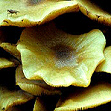
Image by Dr Brett Summerell
Symptoms
This is a vigorous fungus that attacks the roots of trees and is not normally noticed until dieback starts to occur. Affected plants generally appear declined, with some dieback and by this stage; the disease may be well established. Leaves can turn yellow, shrivel and fall from the plant and the branches die back. Citrus trees may produce a heavy crop of fruit just before death. Splits often occur on the trunk of affected trees and the bark may lift revealing white sheets of mycelium or hyphae under the bark. These hyphae will have a distinctive "mushroom" smell. Affected roots become spongy, powdery or jelly-like and when dissected reveal similar white sheaths under the bark. Infected plants may survive for many years before final death of the tree.
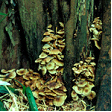
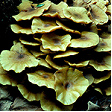
Image by Dr Brett Summerell
Source and Dispersal
This fungus is a native species that is naturally found in Eucalyptus forests and woodlands throughout eastern Australia and south-western Australia. It is commonly found on old tree trunks and decaying wood where honey coloured toadstools appear from the base of the host or surrounding soil in May-June. The toadstools produce white spores that are dispersed by wind, but generally the fungus spreads underground through contact between infected and uninfected roots. The fungus can grow about 1-1.5 metres per year along a root. This species, unlike those in the northern hemisphere does not produce rhizomorphs, thick strands that are flat resembling shoe-strings.
 Mycelium on wood
Mycelium on wood 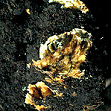
Image by Dr Brett Summerell
The fungus is not spread by contaminated soil as it only grows in root material. Spread to new sites is either through spore movement (very rare), movement of infected plants or through movement of contaminated wood chip used for mulch. Dead or dying trees should be inspected for the presence of this pathogen prior to use as mulch.
This fungus can survive for many years in infested root and stem material depending on the size of the material and speed of decomposition of the wood.
Favoured Conditions
This fungus prefers sandy soil types and is more frequently found in more freely drained soils. Moisture is required for growth of the fungus along the root system. Generally the damage caused to plants is greater on plants that are already under stress or weakened. The retention of infested root systems and stumps in the soil has contributed to an increase in the occurrence of this disease.
Affected Plants
The host range for this fungus is extremely wide and includes many ornamentals and Australian native plants. Fruit trees and perennials are also commonly attacked. The most susceptible species include oaks, camellias, azaleas, roses and eucalypts.
Amaryllis, Narcissus and Hippeastrum species are also infected.
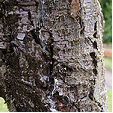 Cedrus species trunk
Cedrus species trunk 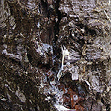
Image by Dr Brett Summerell
Cedrus species are also affected by Armillaria root rot causing the roots to rot and the trunk to swell and spilt open. There is no control for these infections.
Non-chemical Control
Control of this disease is totally dependent on removal of the inoculum of the fungus from the soil. To be effective this will require removal of the infested roots and stem, a process that may be difficult in garden beds. Infected plants should be removed and disposed of, but it is not necessary to remove the surrounding soil as the fungus only occurs in the plant. When clearing affected land for cultivation, remove all stumps and roots and allow 2 to 3 years prior to replanting.
Trees that are in the early stages of attack may be saved by removal of the affected roots and leaving remaining roots exposed for several years. Top soil around the trunk should also be removed for a distance of up to 1m and affected trees should be fertilised and watered to encourage vigour.
Chemical Control
There is no practical or effective chemical control. Fumigation has been carried out to eradicate the fungus but success is dependent on the removal of large sources of inoculum. However many of the chemicals used for this purpose are highly toxic and have restricted usage now.
Note
Always read the label for registration details and direction of use prior to application of any chemicals.
Amendments by
Dr Brett Summerell
Director Science and Public Programs
Royal Botanic Gardens Trust, Sydney
Average Lowest Temperature : -10º C 14º F
USDA : 4, 5, 6, 7, 8, 9
This USDA (United States Department of Agriculture) hardiness zone chart can be used to indicate a plant’s ability to withstand average minimum temperatures. However, other factors such as soil type, pH, and moisture, drainage, humidity and exposure to sun and wind will also have a direct effect on your plant’s survival. Use this chart only as a guide, always keep the other factors in mind when deciding where, when and what to plant.
A plant's individual USDA zone can be found in the Plant Overview.
Region of origin
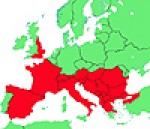
Southern and Western Europe
Climate Description
Cool to Cold
These zones have low winter temperatures with moderate humidity and moderate summer temperatures.
Frosts and snow are severe. Droughts rarely occur and wind is cold.
Plant growth
Endemic native and exotic cool climate plants grow well within these zones.
| Dictionary | Growth Habit |
| Leaf Type | Botanic Flower Description |
| Leaf Shape | Flower Inflorescence |
| Leaf Arrangement | Fruit Type |
| Leaf Margin | Bark Type |
| Leaf Apex And Bases | Flower Description |